Do you know who had the best offensive corners in Allsvenskan 2021? The answer is not Malmö FF or Djurgården, but Bartosz Grzelak’s AIK. The Gnaget finished ninth in 2020, not even making to the top half of the table. However, under the leadership of Grzelak, they improved crazily and became a title contender within a year. Only in the last match week, Malmö were able to claim the title.
Behind their success was not only about the contributions of players such as Nicolás Stefanelli, Bilal Hussein, and Erick Otieno. A very important part is their set-plays attack, which won them crucial points in the journey. Compared to the previous year, AIK scored 6 more corner goals, raising the figure from 7 to 13. Valuable goals such as those against Kalmar, Häcken, and Örebro SK were all attributed to the corners.
How did they become the best Allsvenskan team in terms of offensive set-plays? This set-piece analysis will break down the key components of their corners by considering their individual qualities and opponents as the contexts.
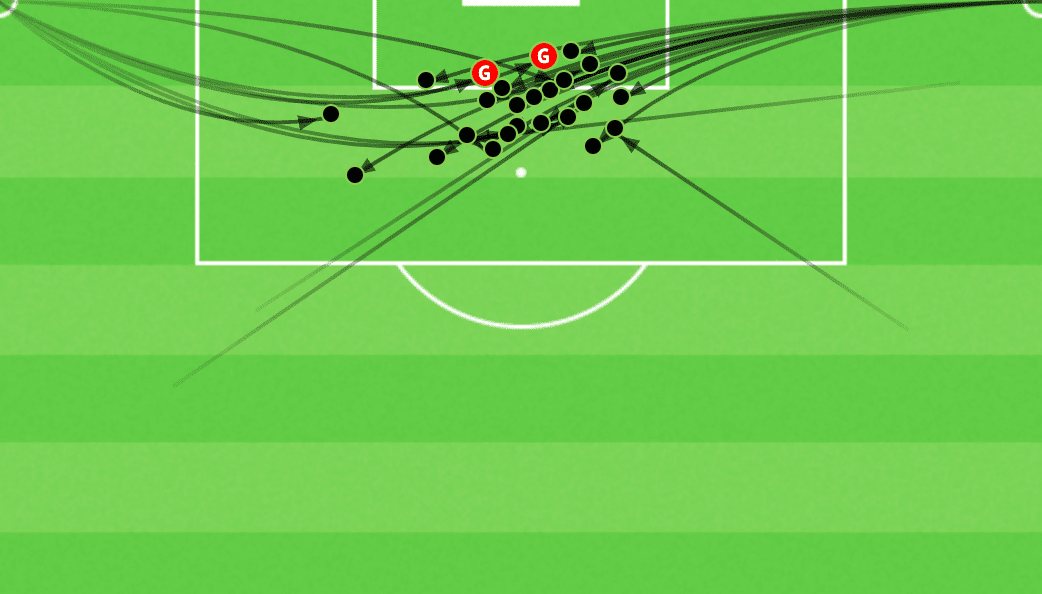
Firstly, we are reviewing the attacking corners of AIK with graphs to show “what are AIK doing”. The above image includes all corners taken in their last 10 Allsvenskan games, although only two goals were scored, they delivered the ball to the edge of the six-yard box, or mostly within the 12-yard spaces. These positions were closer to the goal, which gave the opposition keeper less time to react.
The kicker is the former Arsenal player, Sebastian Larsson, in charge of these dead balls on both flanks, he also had experience with Sunderland in the Premier League. Hence, most deliveries were outswing from the right and inswing from the left. There were also other takers, including Saku Ylätupa, Hussein, Tom Strannegard, and Zachary Elbouzedi but Larsson was fit enough to take most of them.
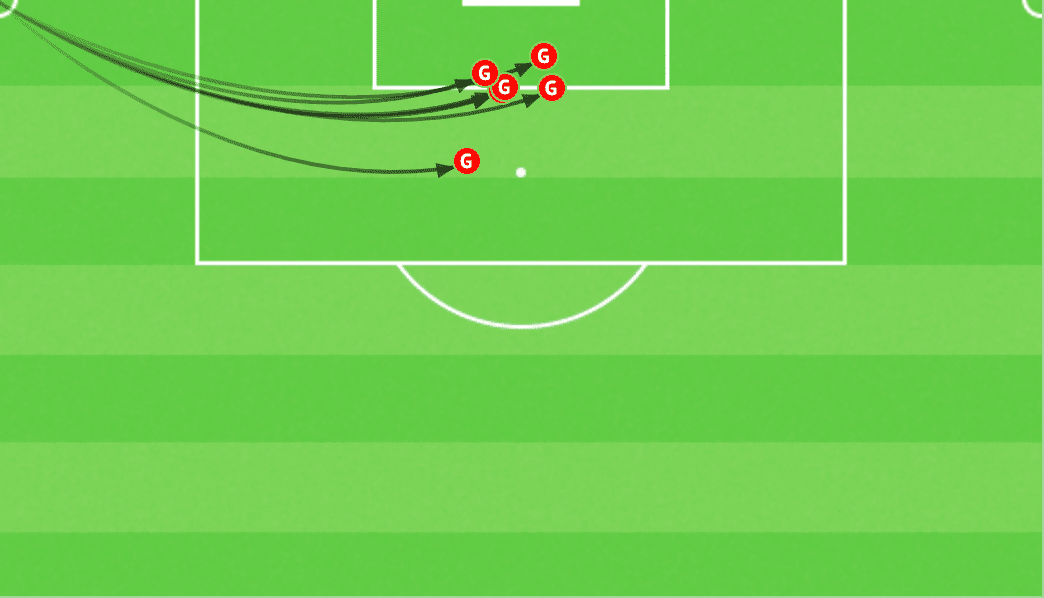
Here, we can see how the goals are scored. All goals from the left side were inswing deliveries, and at least five out of the six goals were touching the six-yard line, if not inside the six-yard box. That shows Larsson’s consistent ability to place the ball into those positions.
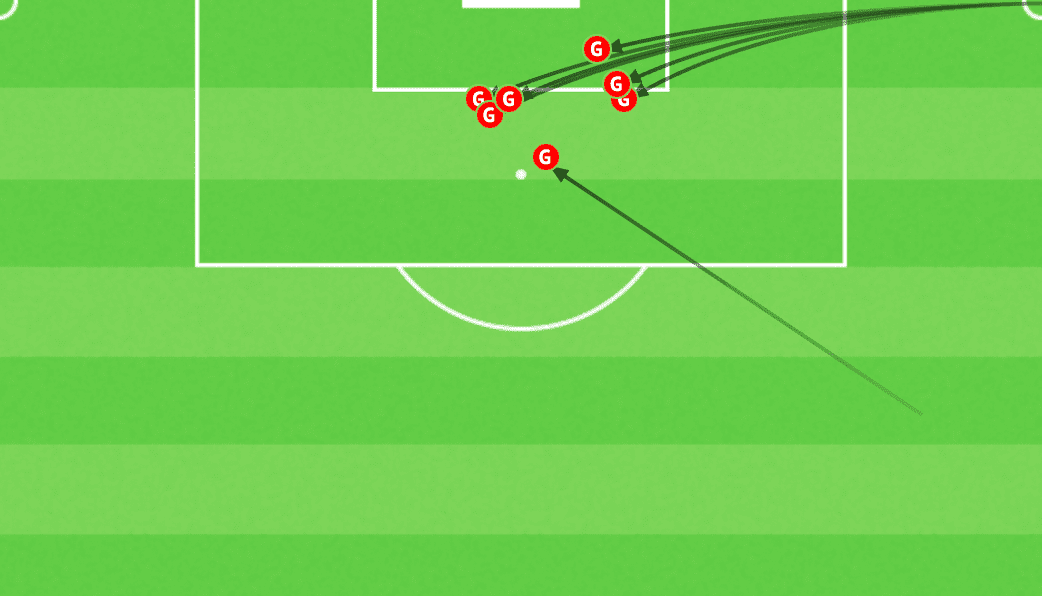
On the right side, as mentioned, they were outswing deliveries. There were six goals from crosses. AIK were very good in this phase without the use of short corners. The crosses were also reaching the six-yard line consistently to allow the big men to head the ball.
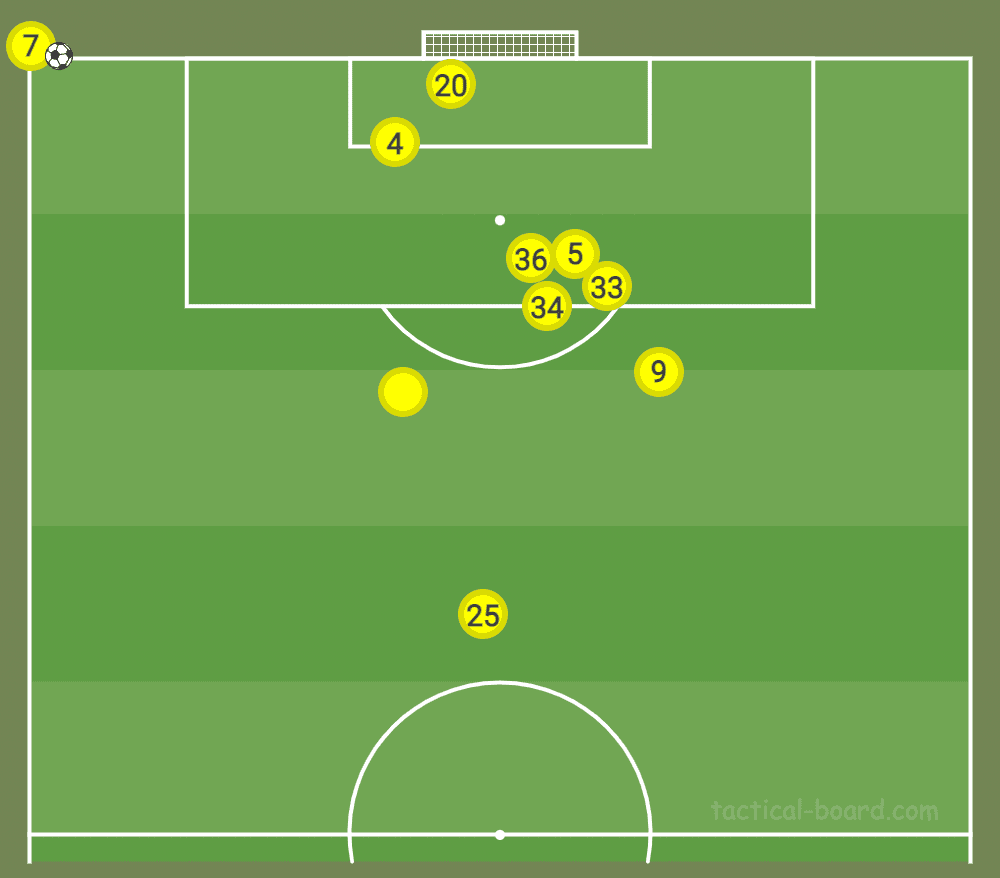
Recently, AIK set up the attacking corners with these initial positionings. Two players were staying in the six-yard box or front side early, and then, there was a four-man group who attacked from deeper areas. The rest defence was formed by a two-man line, mostly including Stefanelli (#9) and another player. Otieno (#25) is the deepest player who covers everyone. We could also note that the centre-backs, Sotirios Papagiannopoulos (#4) and Alexander Milošvić (#5) were not staying together in the same group because they had functional roles in the system.
Scanners to clean spaces
Now, we are going to address “how AIK posed threat” in their attacking corners. They had good defenders but the tactics were more than simply finding their best player, as Papagiannopoulos and Milošević only had two and three goals, the other eight were scored by other outfield players. Despite the setups could change from time to time, there were several tactics that worked quite well.
Usually, the attacking side wanted the targets could meet the deliveries with clear contacts. To create those conditions, even though the targets themselves could be so dominant in the air like Virgil van Dijk of Liverpool, strategies were required.
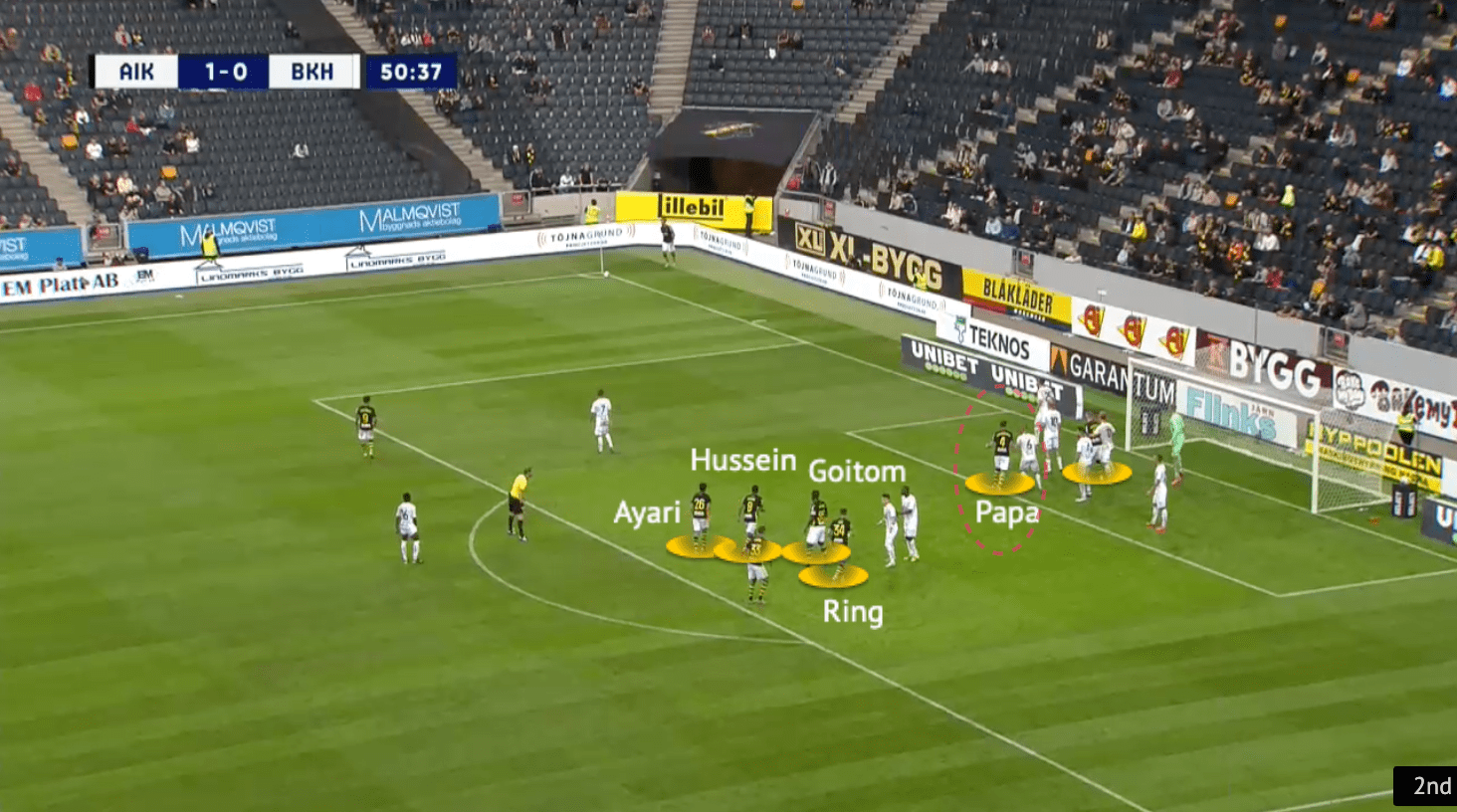
AIK were very good at using the scanners to clean spaces for the deliveries, which allowed the targets to meet the deliveries without too many interferences from the opponents, which was a huge advantage. Even though the deep players sometimes could not make a clear contact in the first attempt, because the scanners cleaned spaces, they could have a second chance to retrieve the dropping ball for another attempt.
This goal against BK Häcken is a good example. Initially, two players were in higher positions, including Papagiannopoulos. Hussein, Goitom, Erik Ring, and Yasin Ayari were attacking from deep. It was Larsson to provide an inswing delivery.
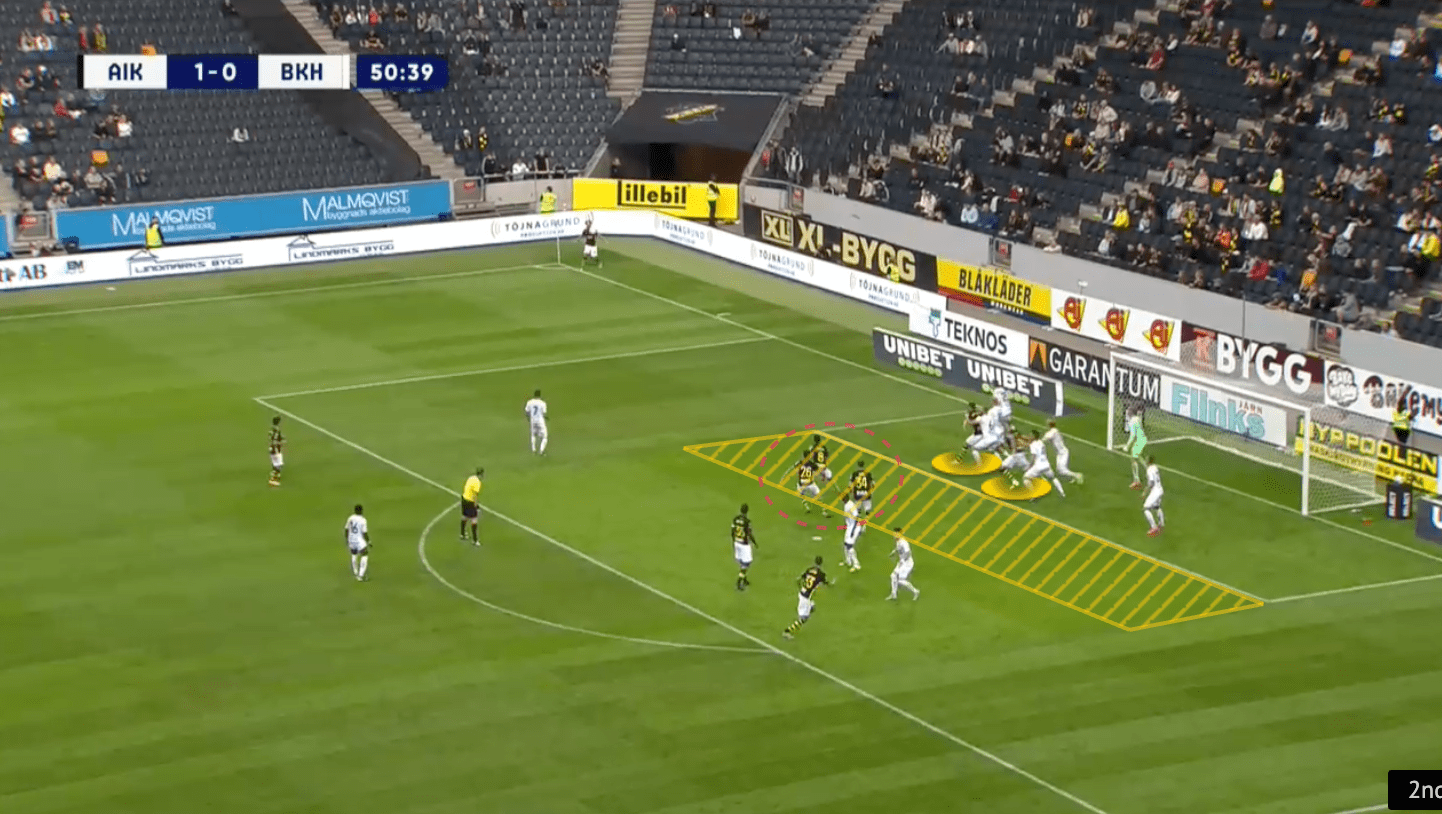
When the ball came, very quickly, instead of attacking the front post to look for a flip, Papagiannopoulos and the other player turned themselves into scanners. Both of them used their physical strengths to hold the oppositions off, as shown in the above image, preventing the zonal defenders from jumping out to attempt the cross.
With the 4v2 numerical advantage of the deeper group, AIK had two players arriving in the yellow space, which was vacated because scanners separated the defence into two groups. The first attempt was blocked by the defenders because there was a bunch of players in front of the goal as well.
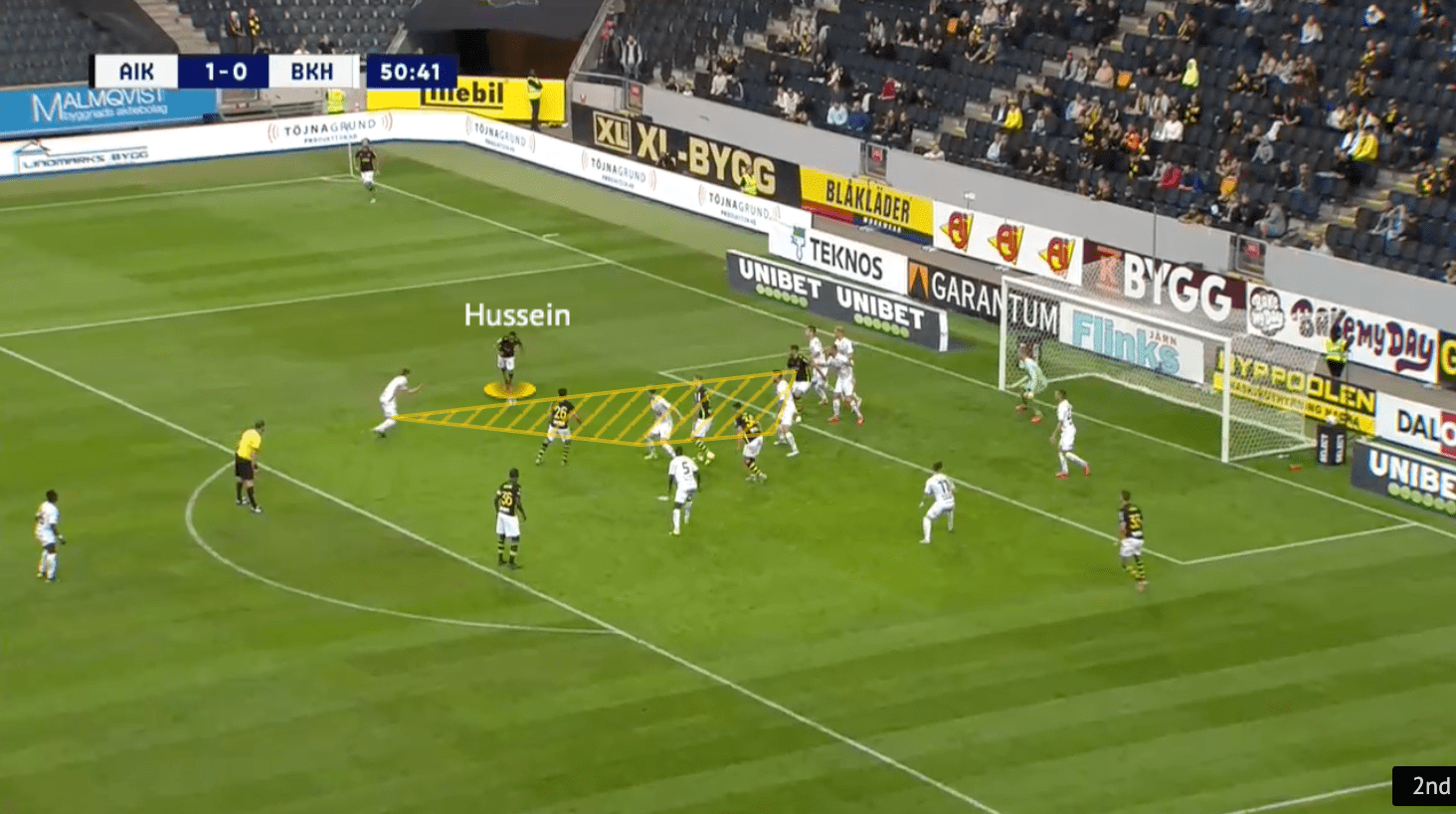
Nevertheless, since Papagiannopoulos already cleaned up that space, Häcken failed to retrieve the second ball, and they could not compress yellow spaces to prevent Hussein taking another shot. This time, the young midfielder scored.
Retrieving the ball after a rebound can be considered luck, but, in AIK’s system, this luck is “forced’ because they simply used the system to increase the probability of winning the second ball.
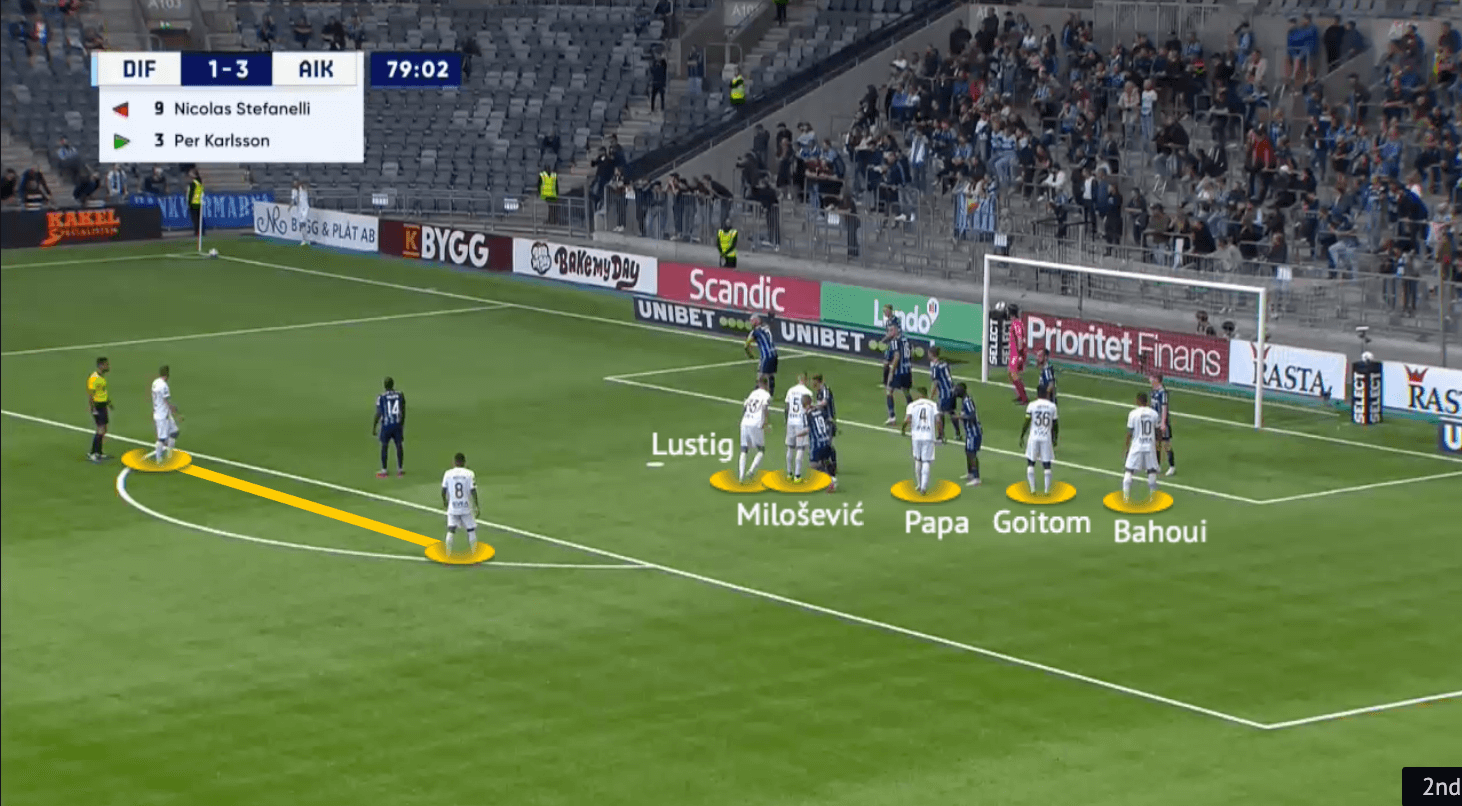
In the Stockholm derby, AIK gave Djurgården a nightmare at the Tele2Arena, one of their goals came from an offensive corner, we could see the use of a scanner as well.
Instead of having a group of two, then, another four players, the beginning positions of AIK players were rather flat in this situation. Mikael Lustig, Milošević, Papagiannopoulos, Goitom, and Nabil Bahoui were spreading evenly to attack the mixed approach (zonal + man-marker) of opponents. The rest defence was formed by two players as usual.
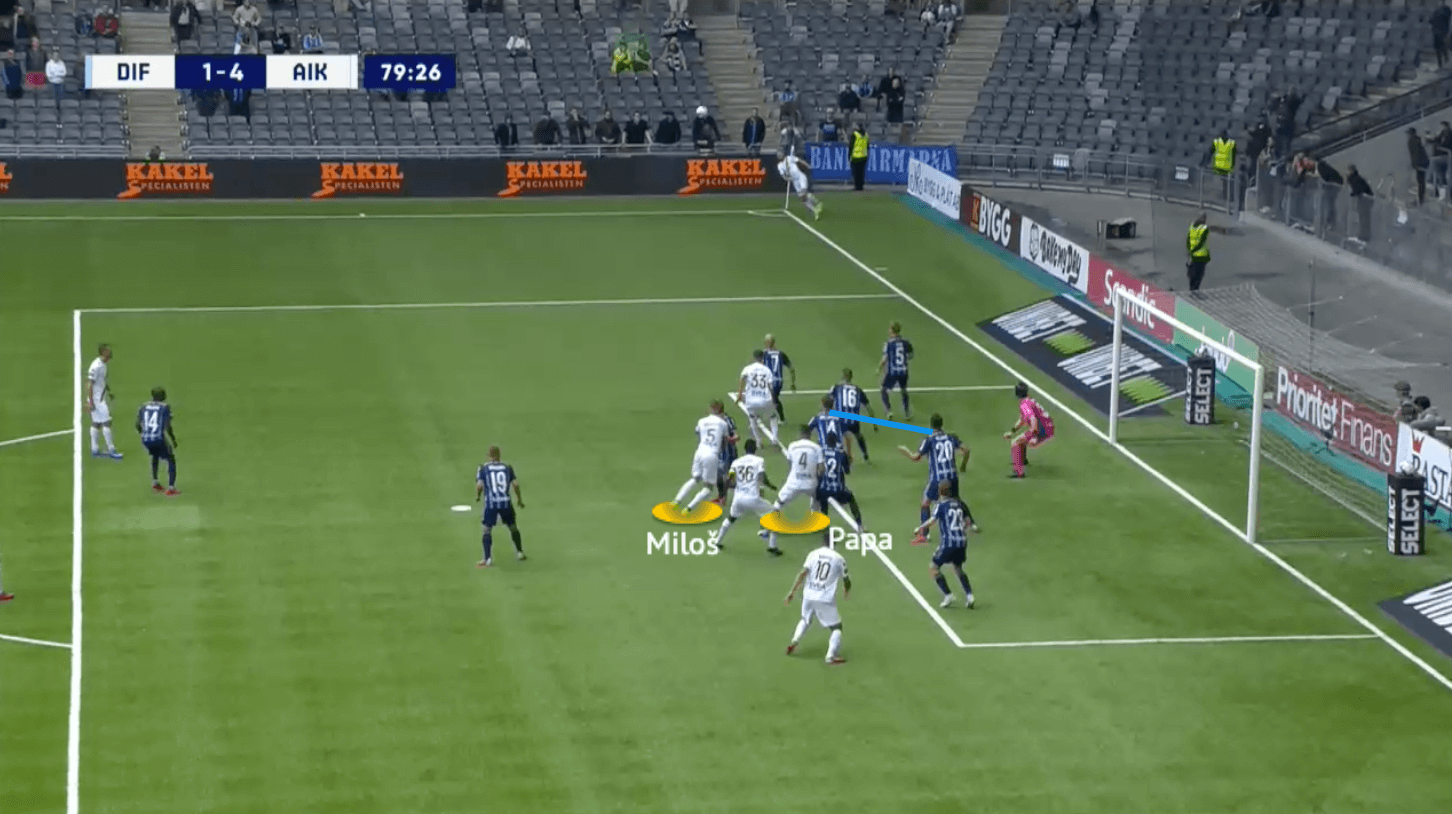
When Larsson delivered, because the players were so close to the six-yard box already, they did not need to travel a far distance. Also, you could see how they bullied the man-markers by scanners to create spaces for the header. The centre-backs were strong, Papagiannopoulos was using his body to push Emmanuel Banda into the six-yard space, that vacated pocket of spaces for Milošević.
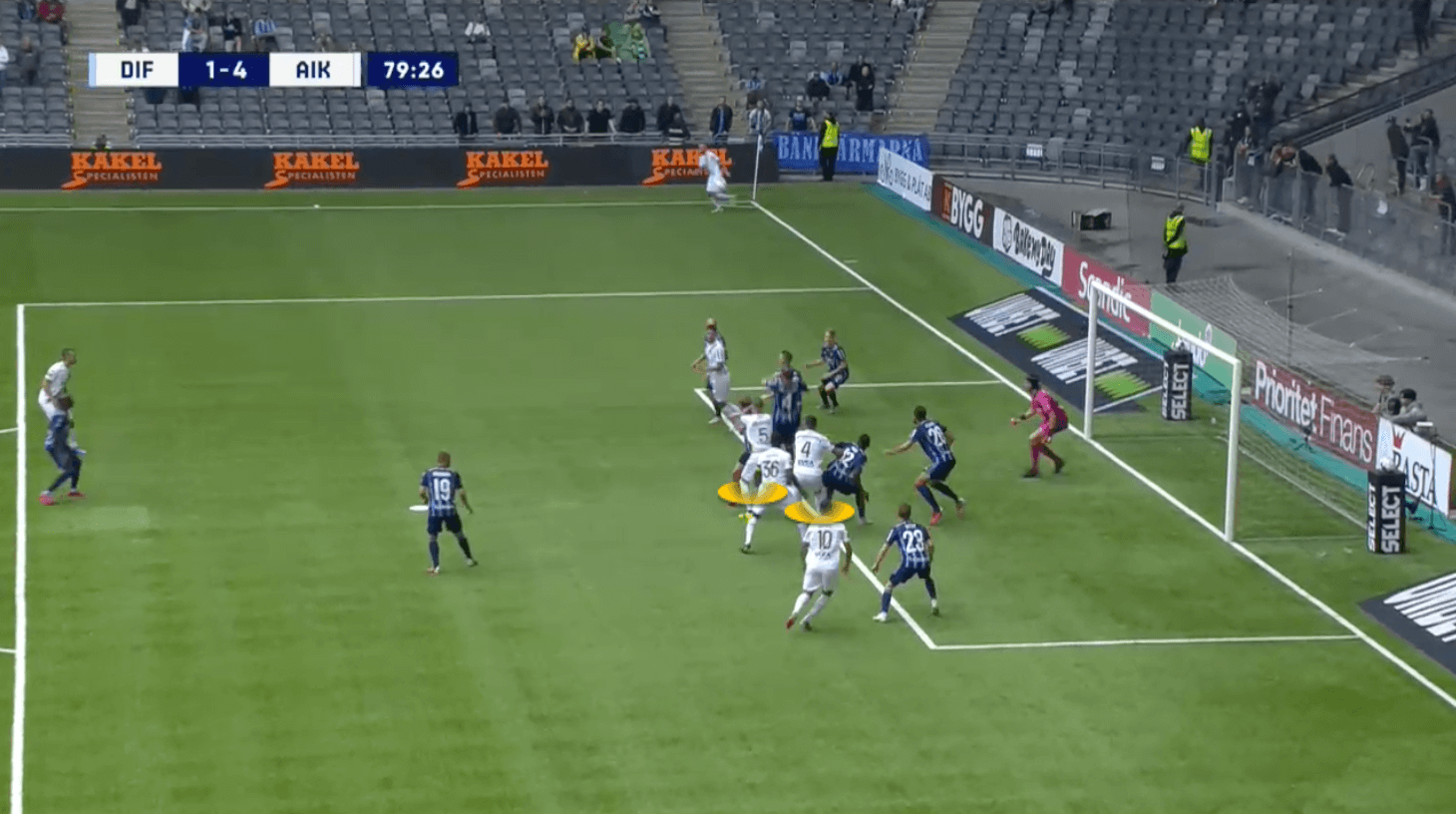
It was a misjudgment from Jacob Une-Larsson as the Djurgården zonal defender did not meet the delivery even he jumped, the ball went above his head. But, the prerequisite to give Milošvić a clear contact without much interference was Papagiannopoulos, who never gave Banda a chance to shift from marking himself to his partner.
Papa in the front side
On the front side, particularly, Papagiannopoulos had a very important tactical role for his side. The previous section already briefly hinted at how the 31-year-old defender could clean spaces for teammates. Based on his strong physique, AIK could also design tactics around by manipulating the opponents. With Papagiannopoulos in the front post, AIK were good at moving the first zonal defender away from his positions to free up more spaces in the central areas/six-yard line.
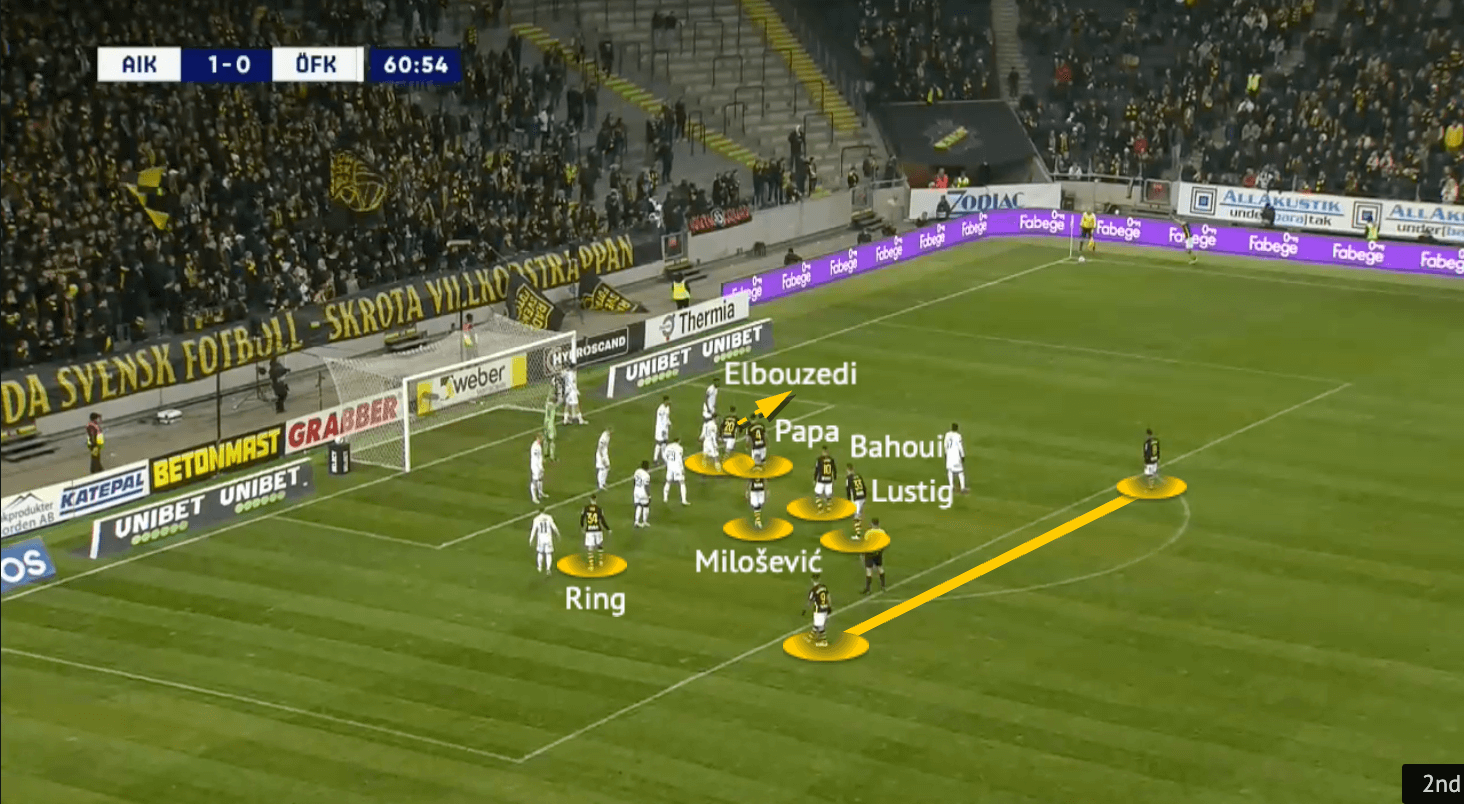
Östersunds FK defended with a zonal system with blockers. The first and second lines both have four players and there was one post player. AIK had Papagiannopoulos and Elbouzedi in the front side, close to the penalty zone. Bahoui, Lustig, Milošević, and Ring spread around the penalty spot.
This was a collaborated move to attack the front post. Firstly, Elbouzedi dashed forward.
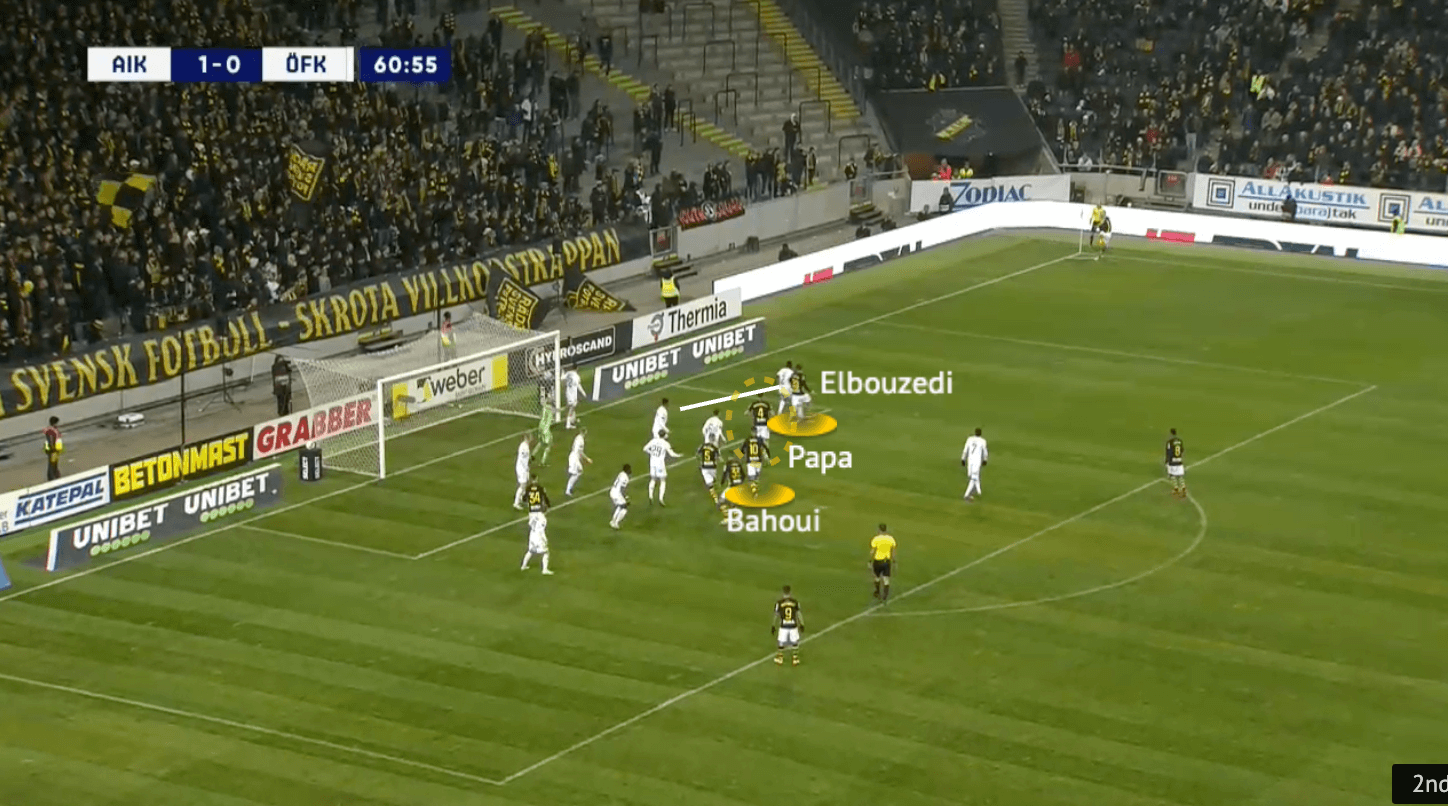
And as shown above, Elbouzedi’s early run took Patrick Kpozo, the first Östersunds zonal defender away from his position. Now, Kpozo was distanced from Noah Sonko Sundberg, and Papagiannopoulos was attacking that gap. Simultaneously, Baohui was also attacking but we were yet to see where he was going yet.
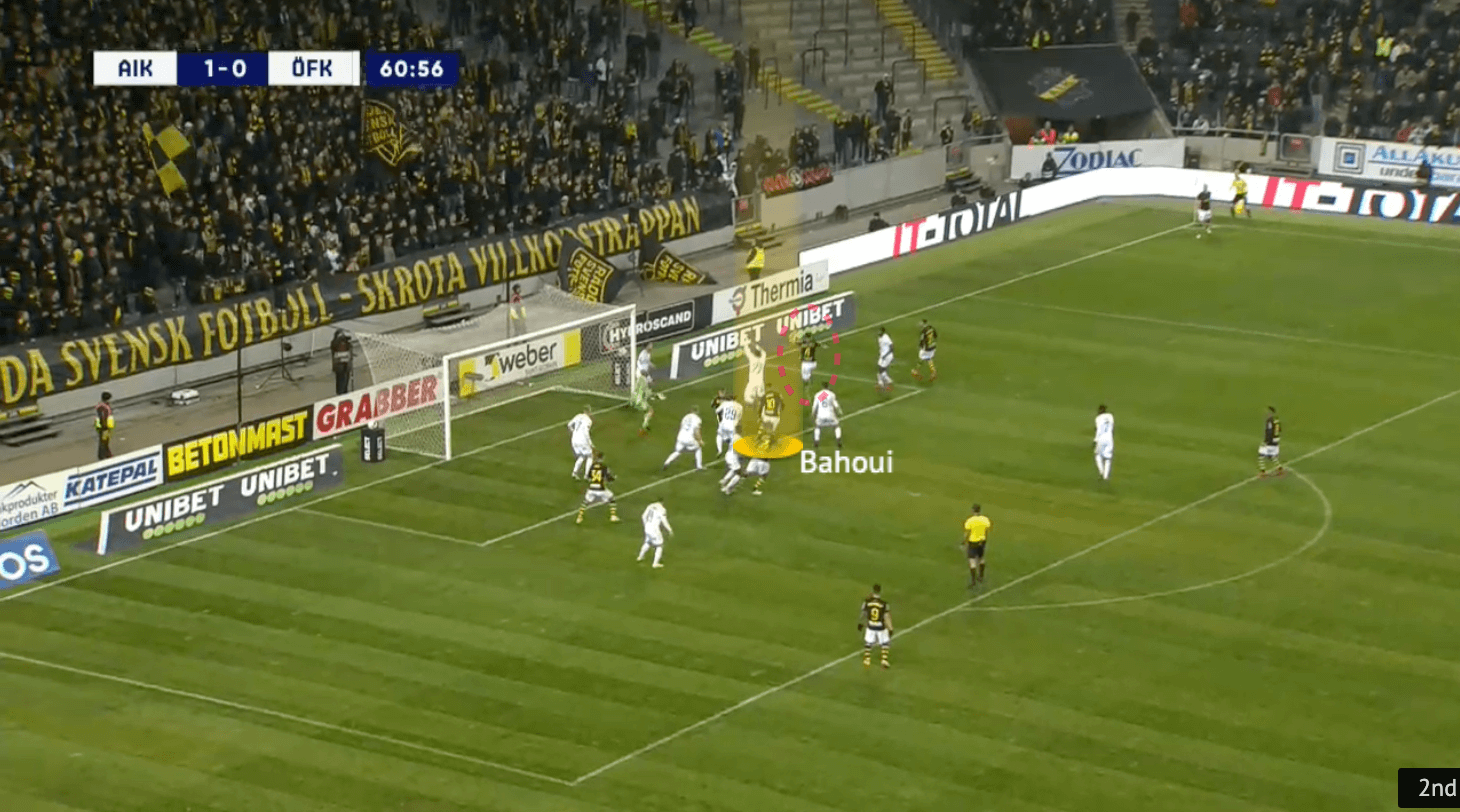
Now, it was clear. Since Elbouzedi opened the front side, Papagiannopoulos can compete with Sundberg in that area. He was not good at flipping the ball but would still be a great threat when given that many spaces.
Also, since Papagiannopoulos’s movement took away the second zonal defender, there was another gap opened between the second and third defender. This was where Bahoui arrived, the 31-year-old attacker already sneaked into that space. In case Papagiannopoulos could not attempt on goal, the ball might drop into that zone and Bahoui was in a good position for a second ball opportunity close to the goal.
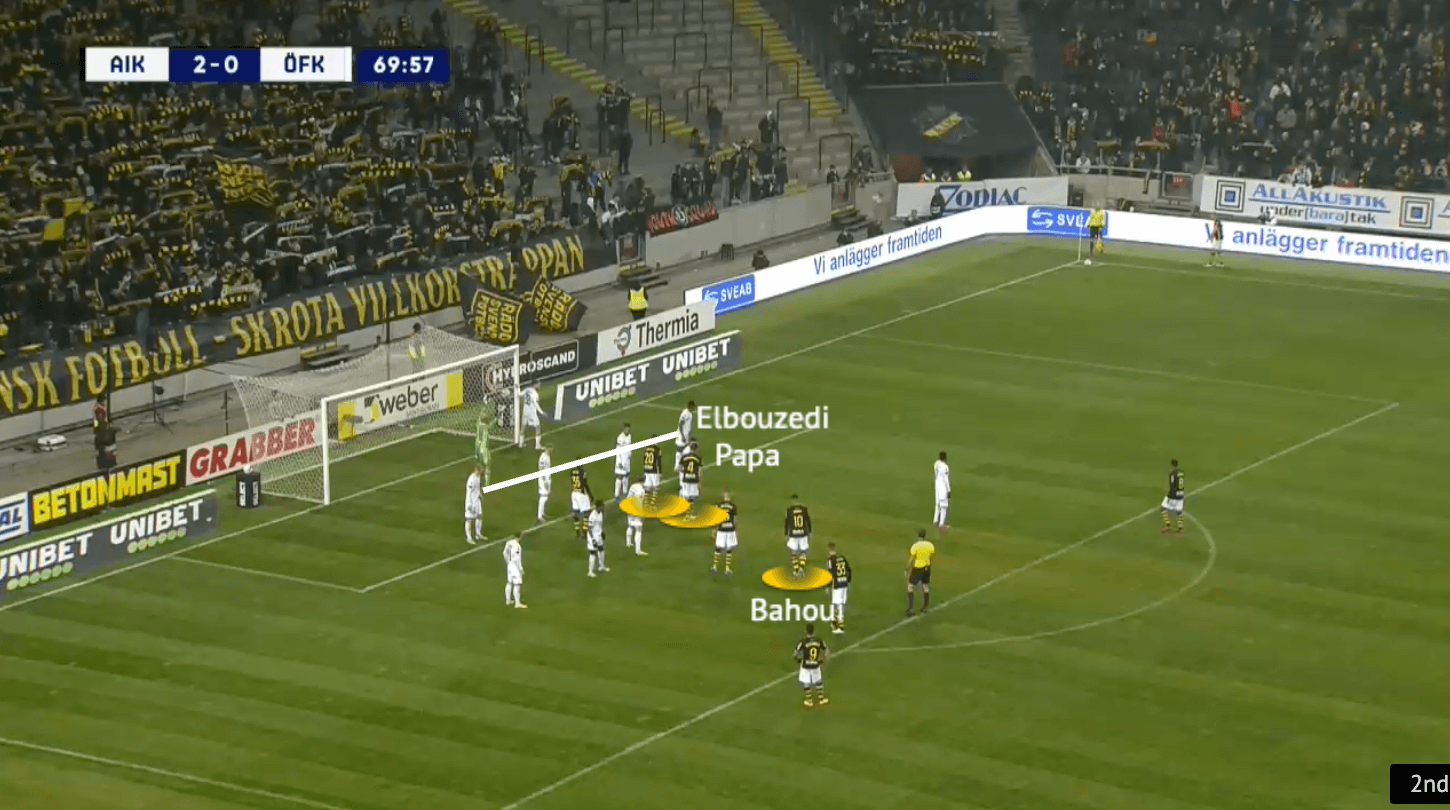
The previous example was not a coincidence because we saw them doing the same just after 10 minutes. Again, they intended to attack the zonal chain with movements. Elbouzedi and Papagiannopoulos were the highest players in the penalty zone.
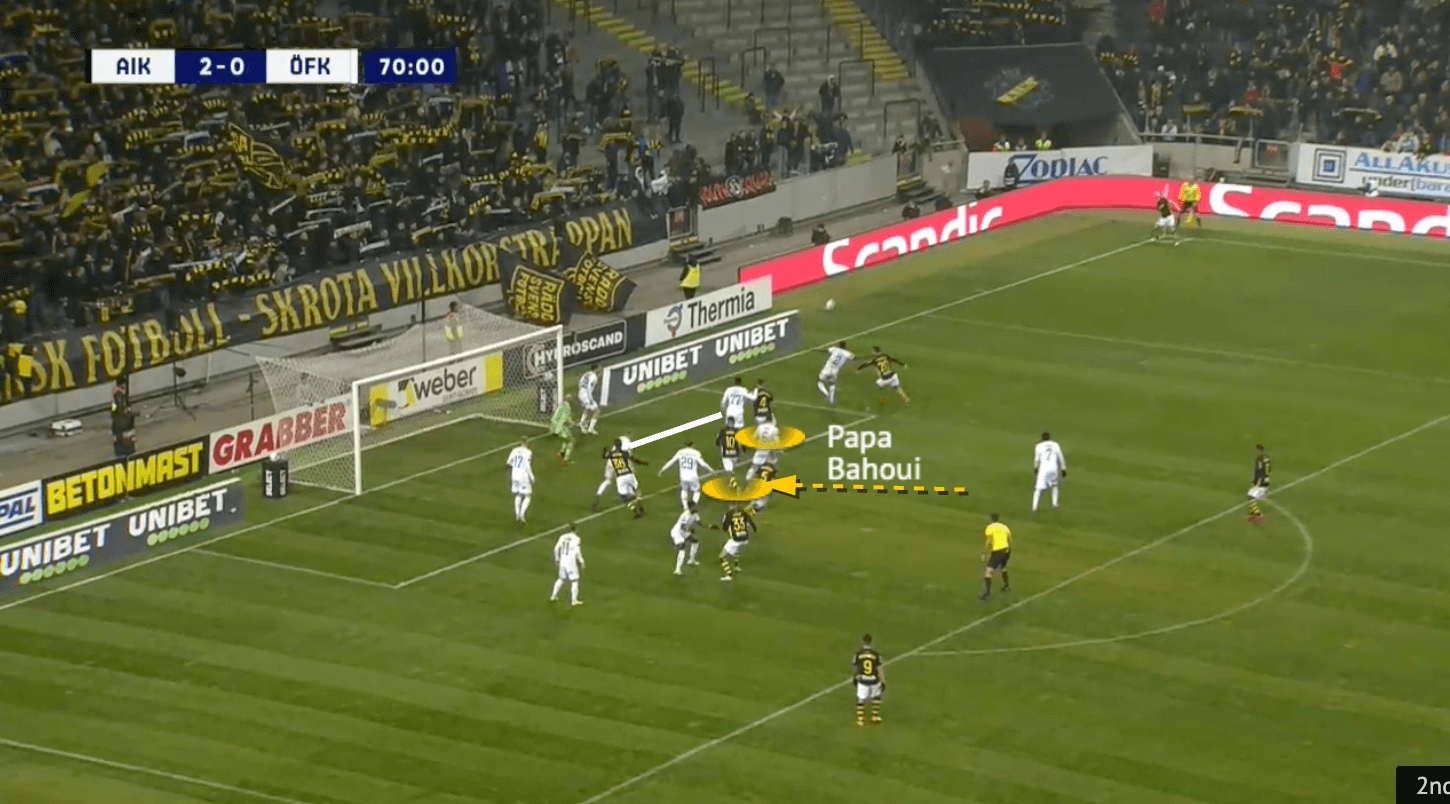
Again, the same moves. Elbouzedi took away Kpozo to make sure the first zonal defender could not defend the six-yard box. Then, Papagiannopoulos exploits that gap between Sundberg and Kpozo, with a deep run from Bahoui to attack the gap behind the second defender, as Sundberg must compete with Papagiannopoulos. The angle of this image was even clearer as we indicated which gap was Bahoui attacking.
If the ball dropped into that space, it could be a simple tap-in goal. That shows again how AIK could “force” luck with their system.
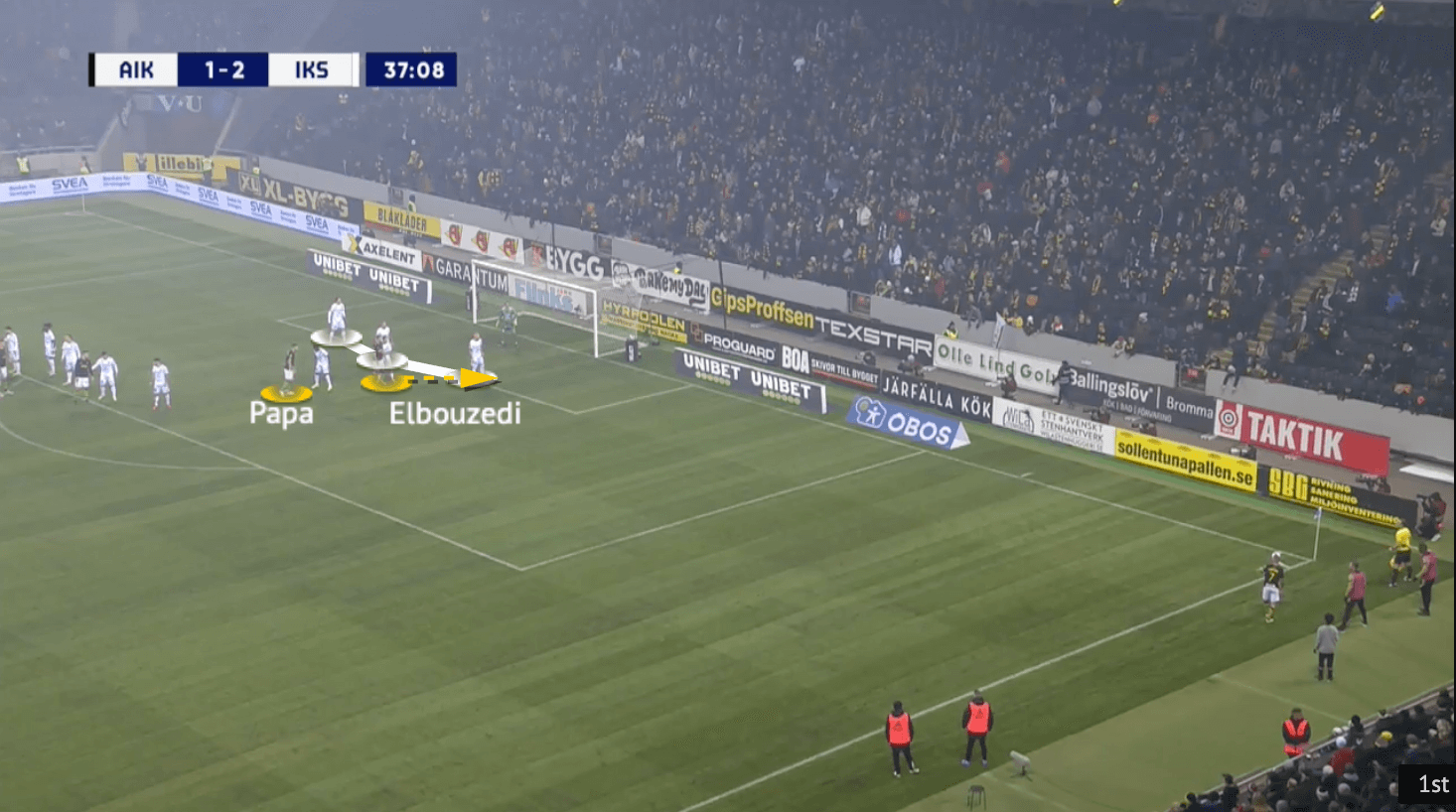
Apart from using the decoy moves to pull out spaces in the front side, Papagiannopoulos also had other functional roles. The players on the front side could transform into blockers if they knew the delivery would go past them.
In this example against Sirius, you could see the benefits of AIK having a group of deep players. They separated the zonal chain and blockers of opponents, created a huge vertical gap between them, and those areas were usually where the deliveries could reach.
As usual, Papagiannopoulos and Elbouzedi were in the box early to begin all moves, both moved early to run towards the ball.
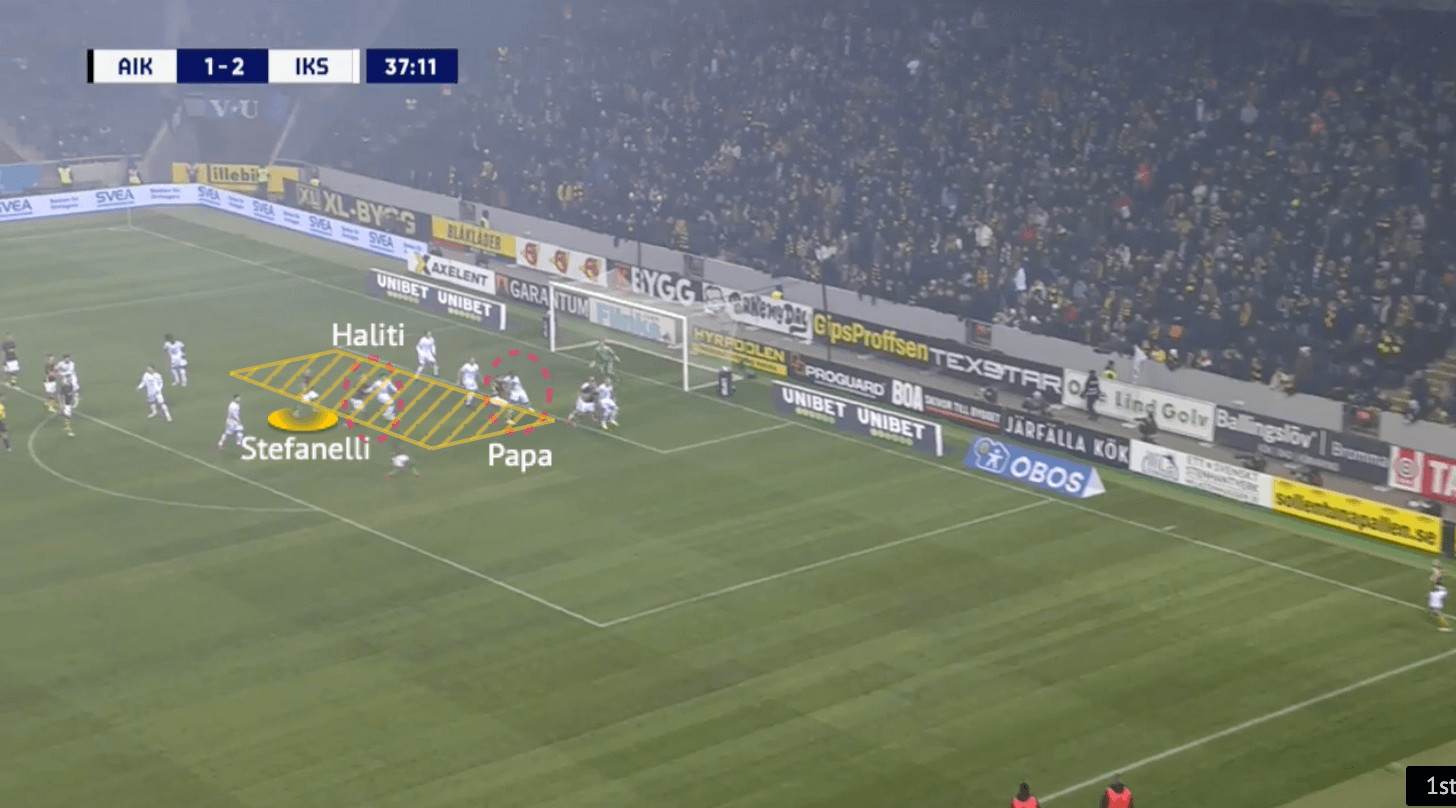
All they needed was the deep attackers running past the blockers, arriving at the yellow space. Stefanelli did well on this occasion, arriving from deep. Then, to prevent defenders contesting with Stefanelli, you could see Papagiannopoulos and Jetmir Halitir immediately transform themselves as blockers.
Deep runner to back post
Apart from attacking in the front side strategically, AIK also carried a threat in the far post with runners from deep. Lately, Lustig was assigned for this task, even though he did not score, the movements he made were a great threat in this phase.
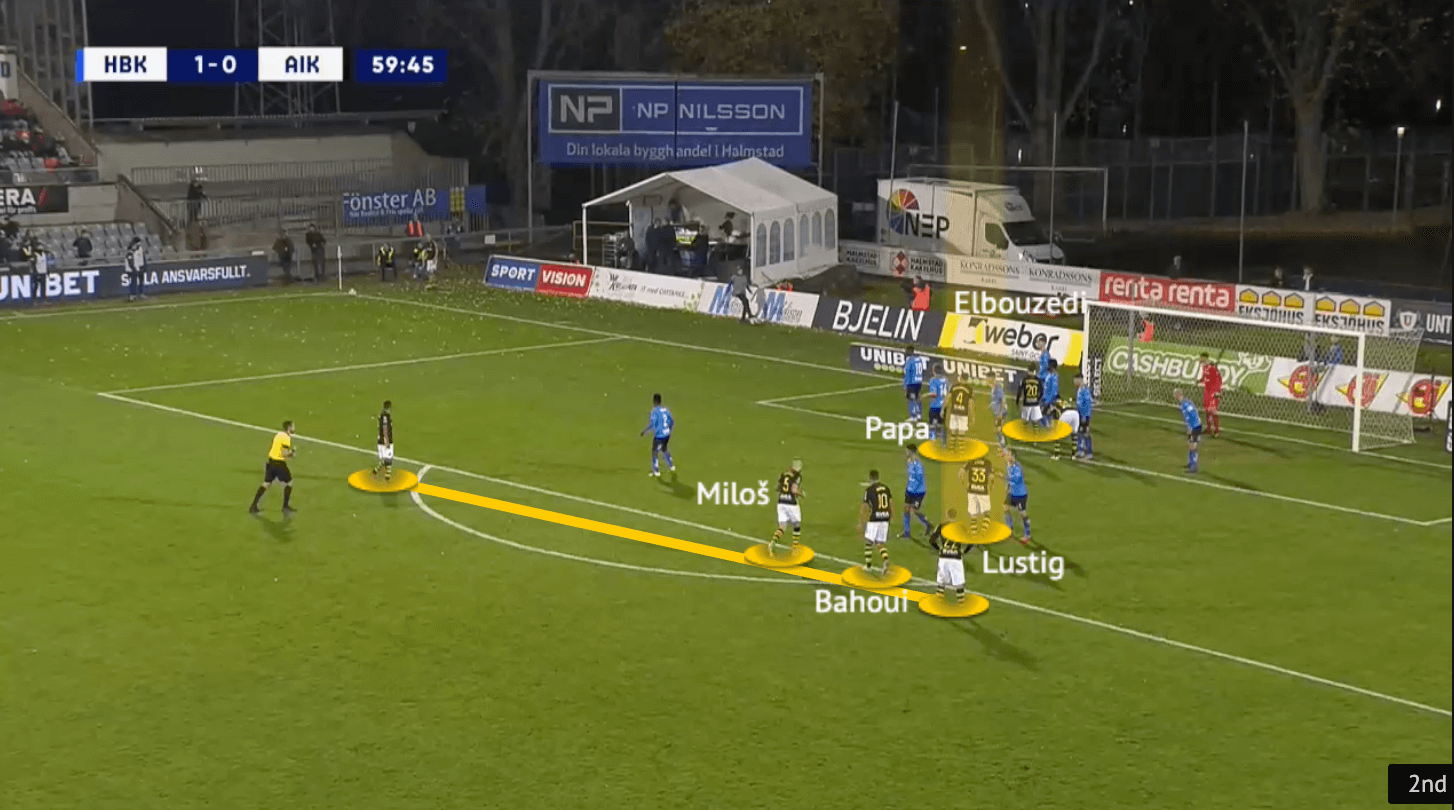
This time, AIK set up in a “3+3” as Goitom was already in the six-yard zone. Nevertheless, Lustig was still in the deeper group. In this example against Halmstad BK, we saw the opponents using zonal defenders plus two man-markers.
The individual dismarking skills of Lustig was brilliant, which we will show in this example.
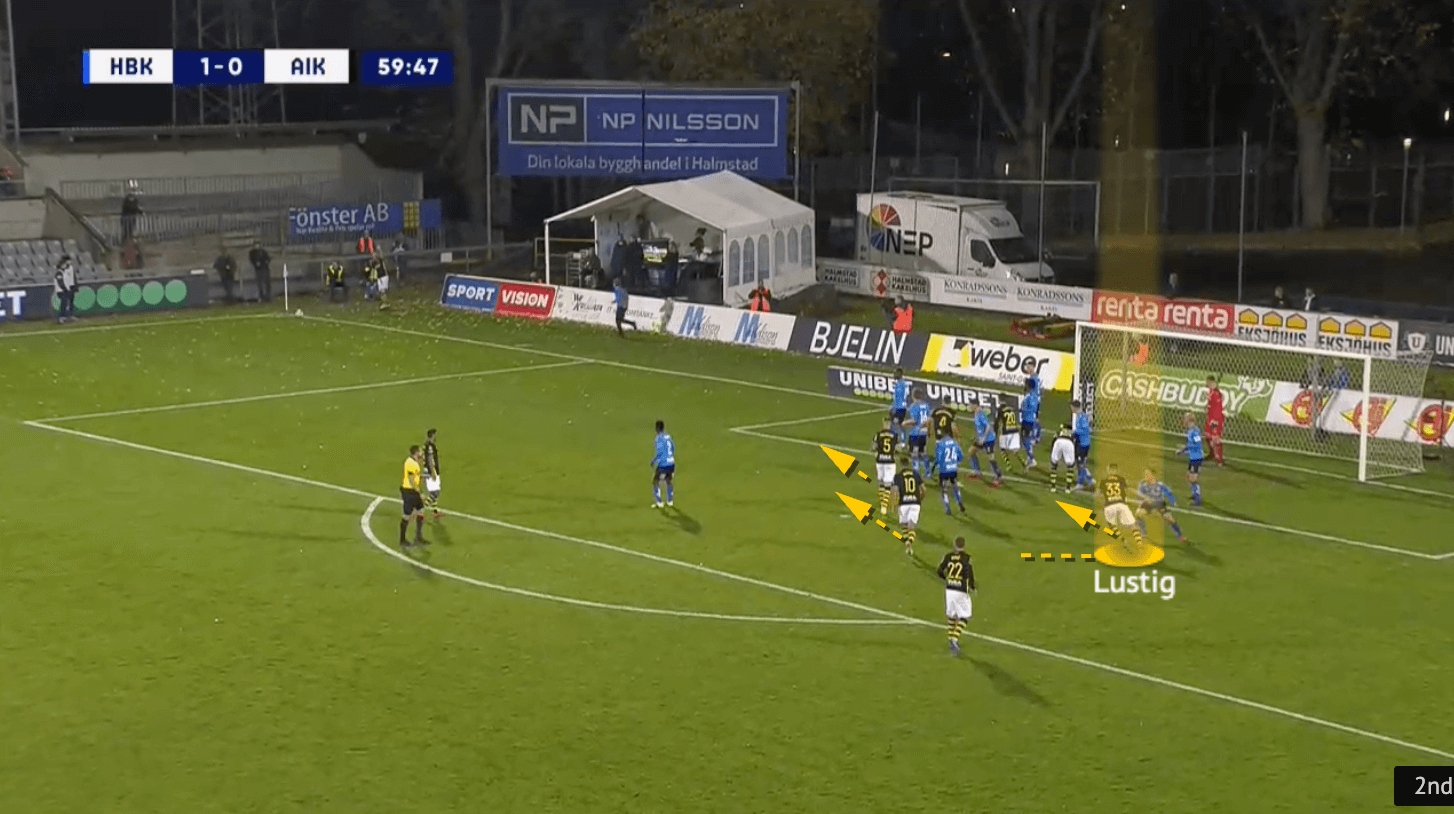
When the move began, Bahoui and Milošvić went to the front side, Lustig was on the opposite side, but his movements were wicked. Firstly, he went to the right side to engage the marker, when the marker’s body orientation was a bit flat, which means he has lost the balance, and Lustig sharply changed his direction to the centre, the marker already lost him.
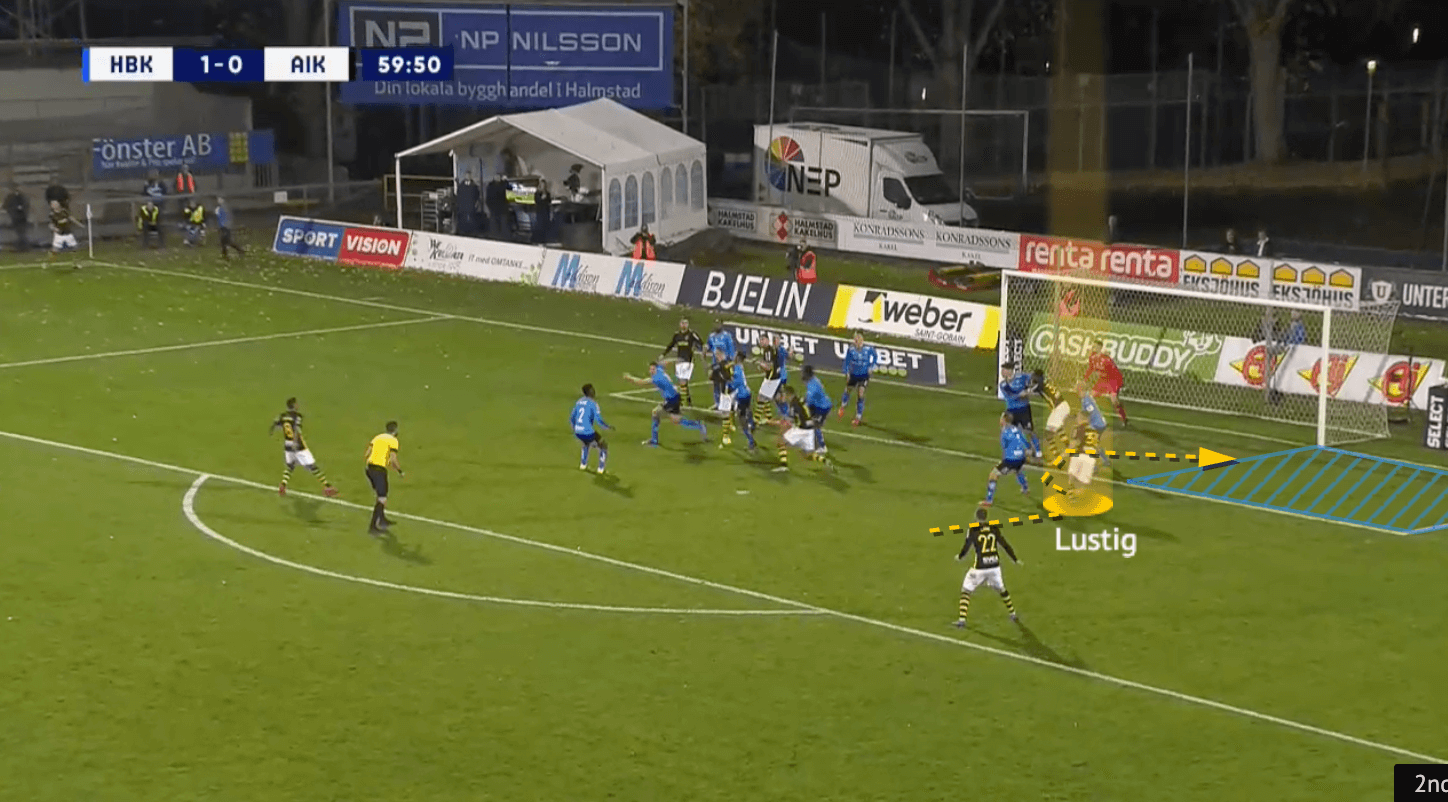
But the delivery was not arriving yet, then, to keep the dynamic, Lustig kept moving. Again, a few body feints helped him to move from the centre to the right, as the marker was off-balance already. The move ended up in the blue zone, where the opponents could not cover. If the ball dropped, that could be a big chance to score.
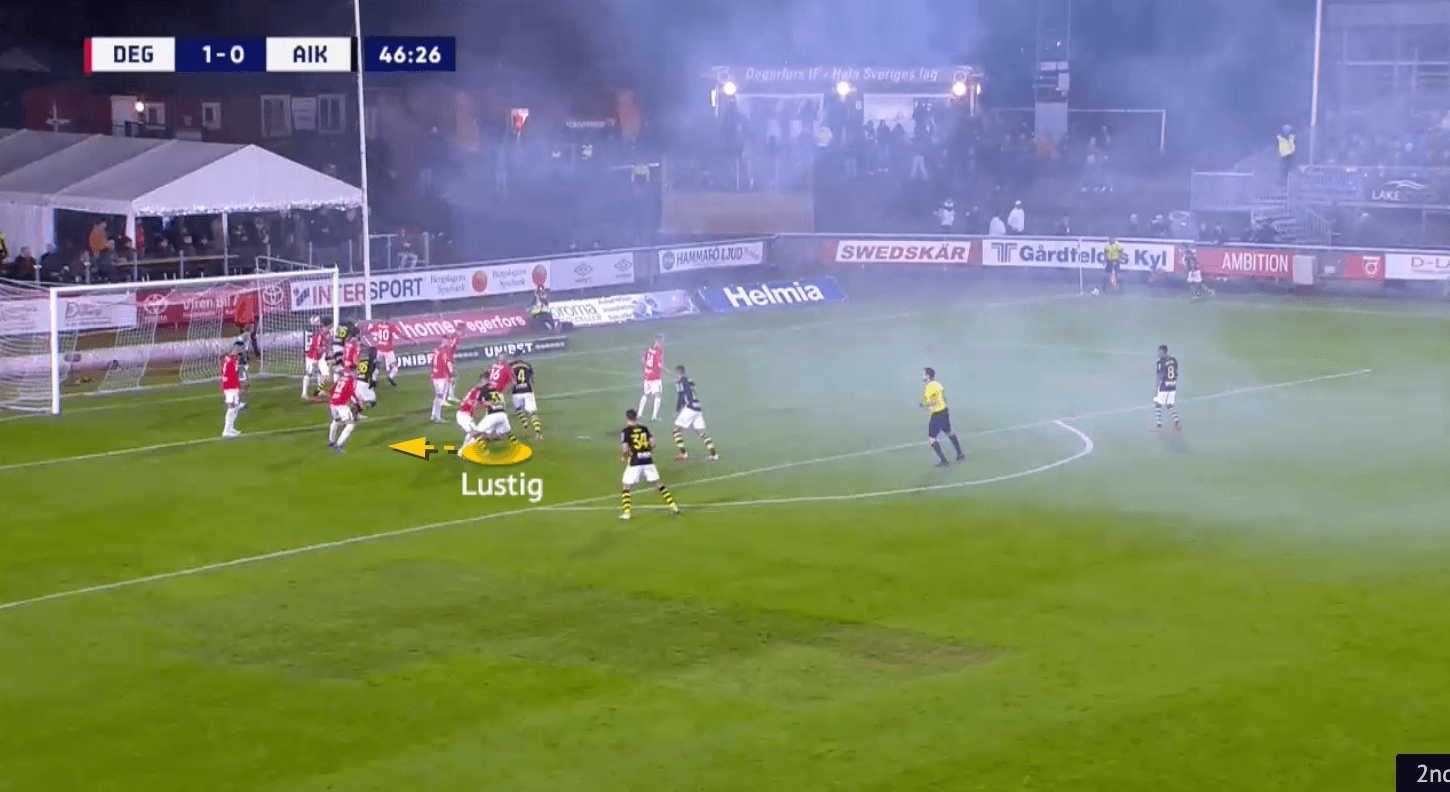
On this occasion against Degerfors, we could see the cleverness of Lustig as a deep runner. The opponent had a zonal chain and man-markers. Here, he went to the left side first to engage the man-marker.
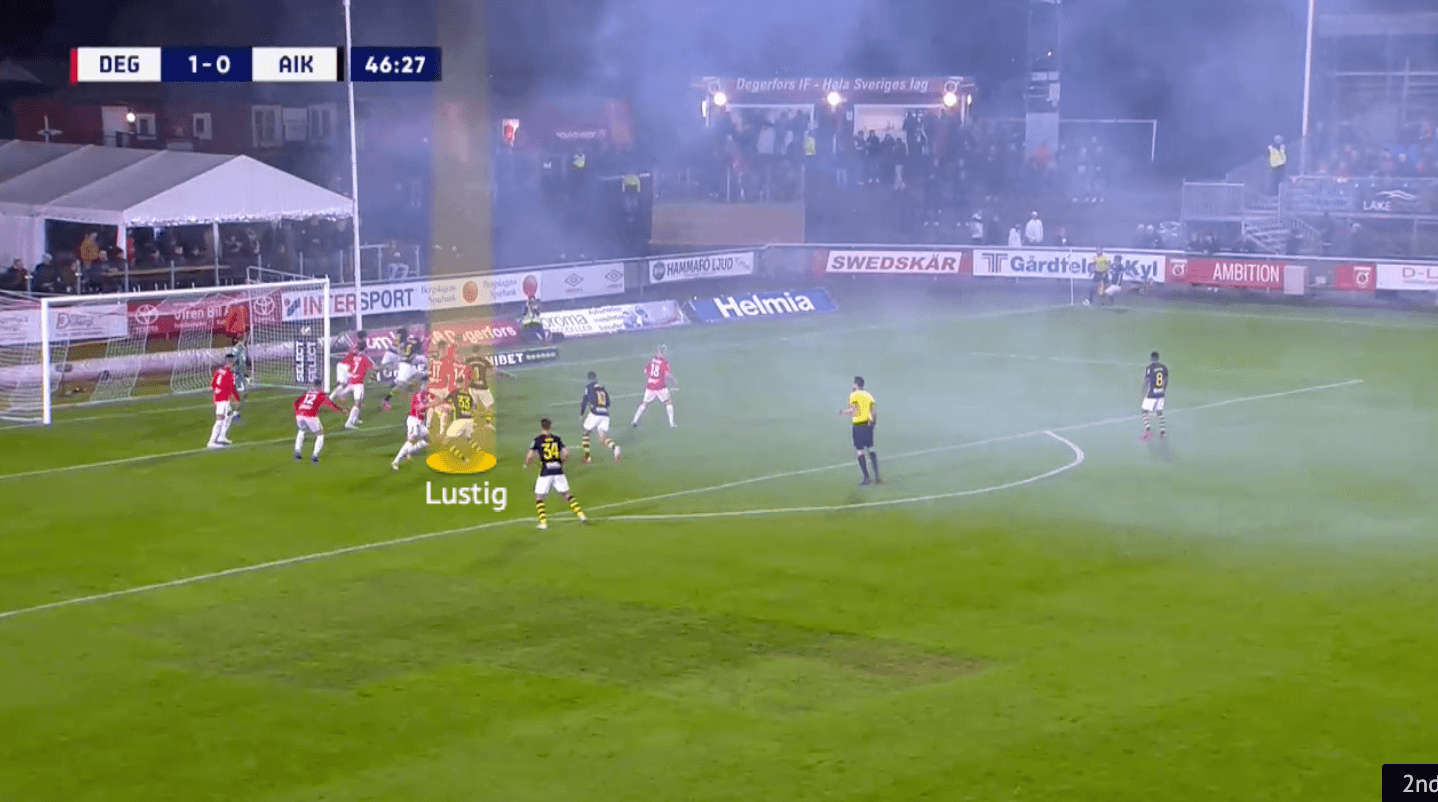
Then, all of a sudden, he checked back to the centre as we highlighted his new position in the above image. The man-marker must react, but he was always late because his actions were adjusted based on what the opponent was doing.
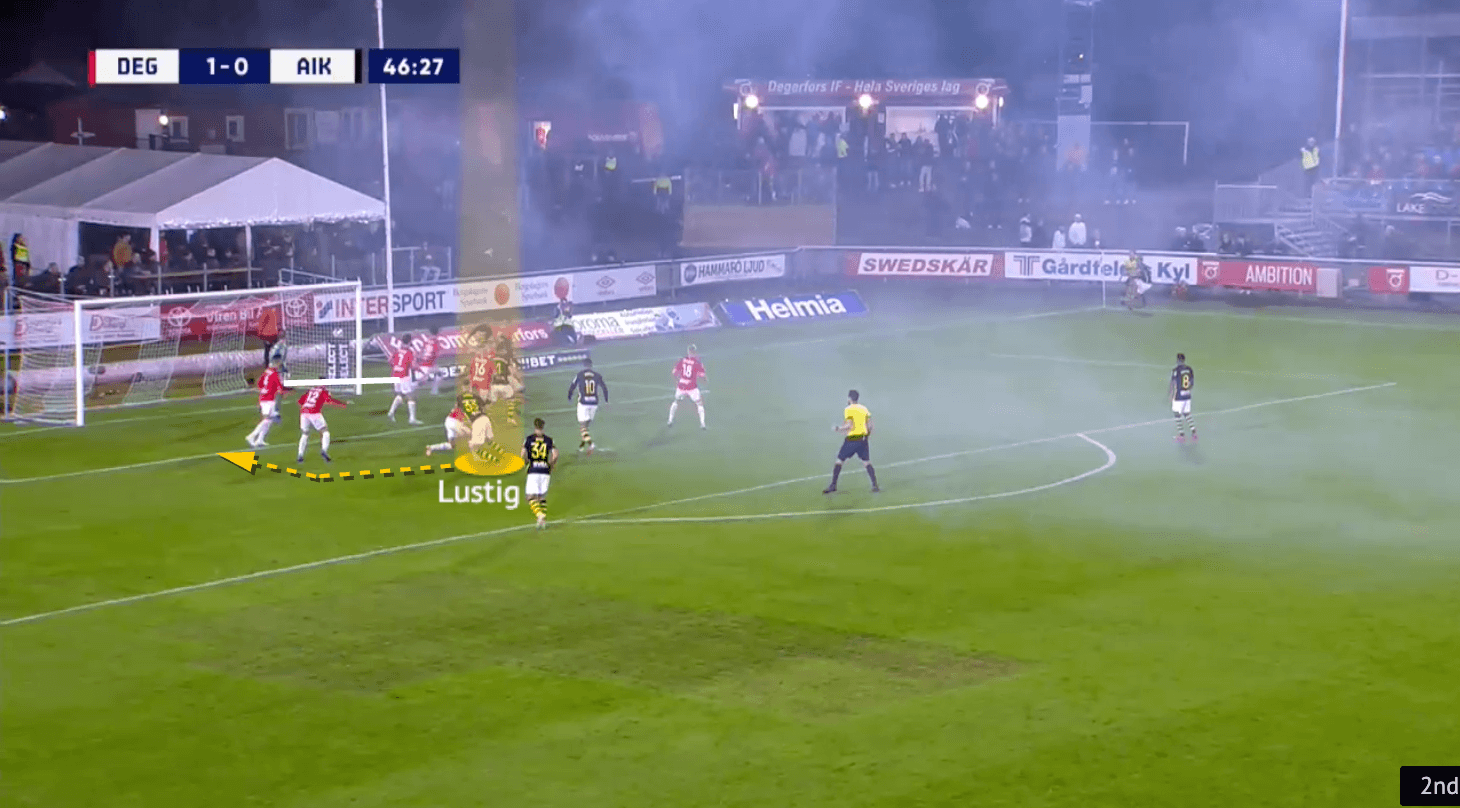
When the man-marker reacted and moved back to the centre, Lustig already changed his direction again because the above moves were just decoys to disguise the opponents.
Next, what mattered was where Lustig chose to attack. Although a big zonal gap was presented as we drew above, the former Celtic defender did not run into that space. Instead, Lustig travelled on the outside of the block, on the blindsides of all defenders. That was a very clever decision because the ball was delivered on the opposite side, if the defenders turned their head to look at Lustig’s move, they could not see the ball, which made them difficult to judge the trajectory of ball.
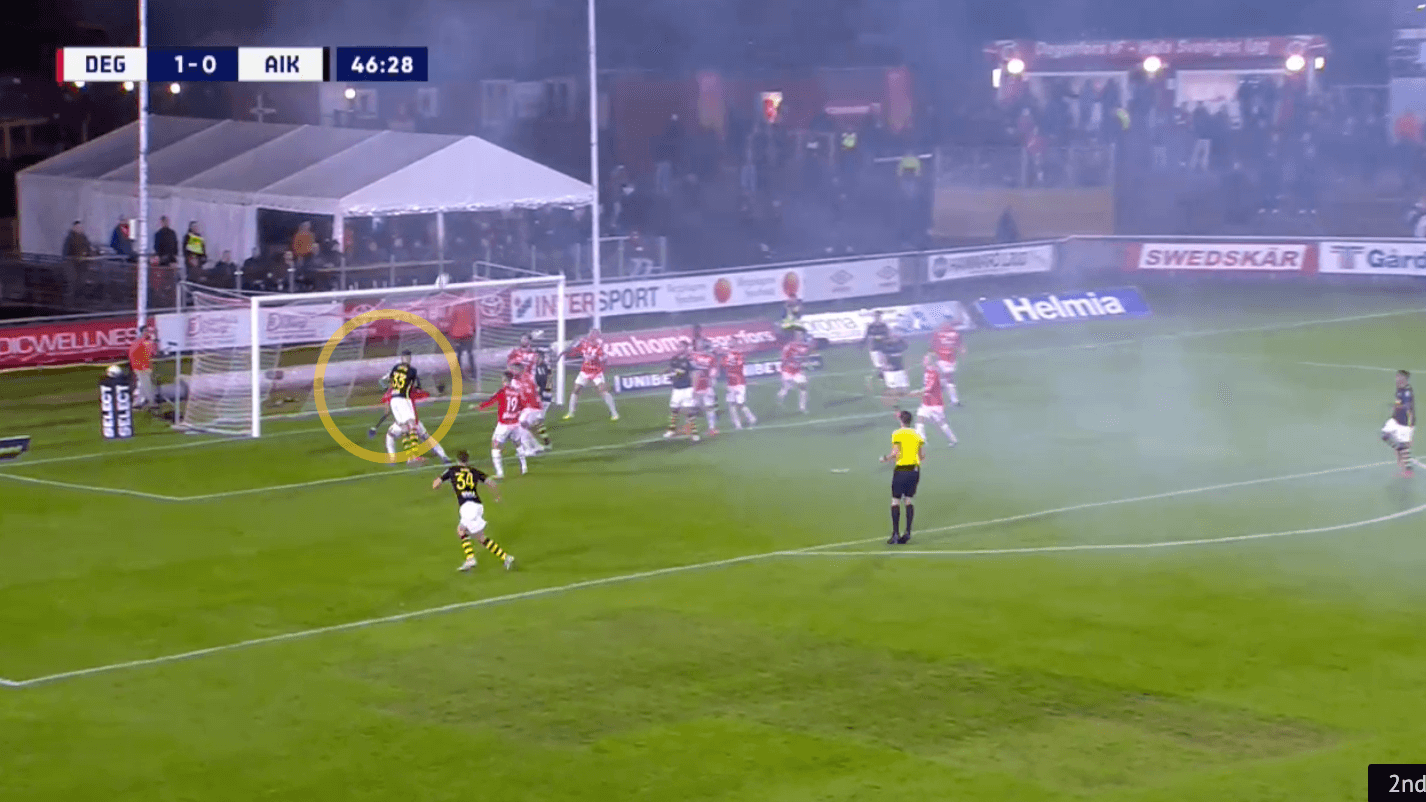
As a result, Lustig arrived easily without interference. The position he selected to attack was clever because he would only be attacking the space of one defender, it was easier to jump and head the ball. It was a shame that the referee cancelled the goal because he thought Lustig fouled on the defender, but the setup, from the disguise movements to running from deep, was great.
Flexible rest defence
In offensive corners, it was not only about the tall and physical defenders. In AIK’s setup, they were very good at looking for a second ball chance and the two-man rest defence also contributed to that greatly. Stefanelli has shown very good intelligence and adaptations in those situations as a rest defence player, his follow-up actions often gave the team a second chance to attack again.
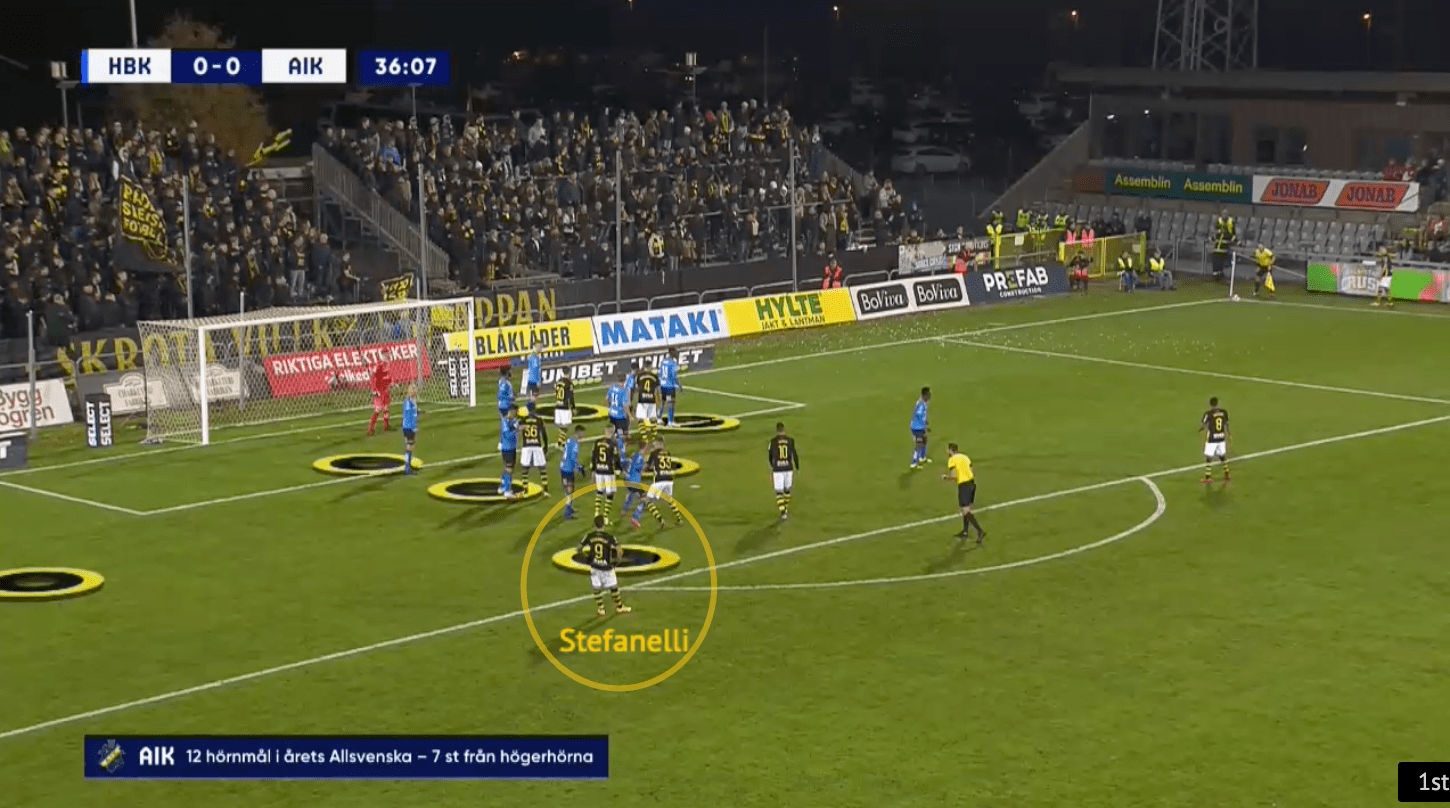
Usually, Stefenalli was a part of the two-man rest defence as shown above. Before the kick, his body language of course was not ready to combat yet – with both arms akimbo.
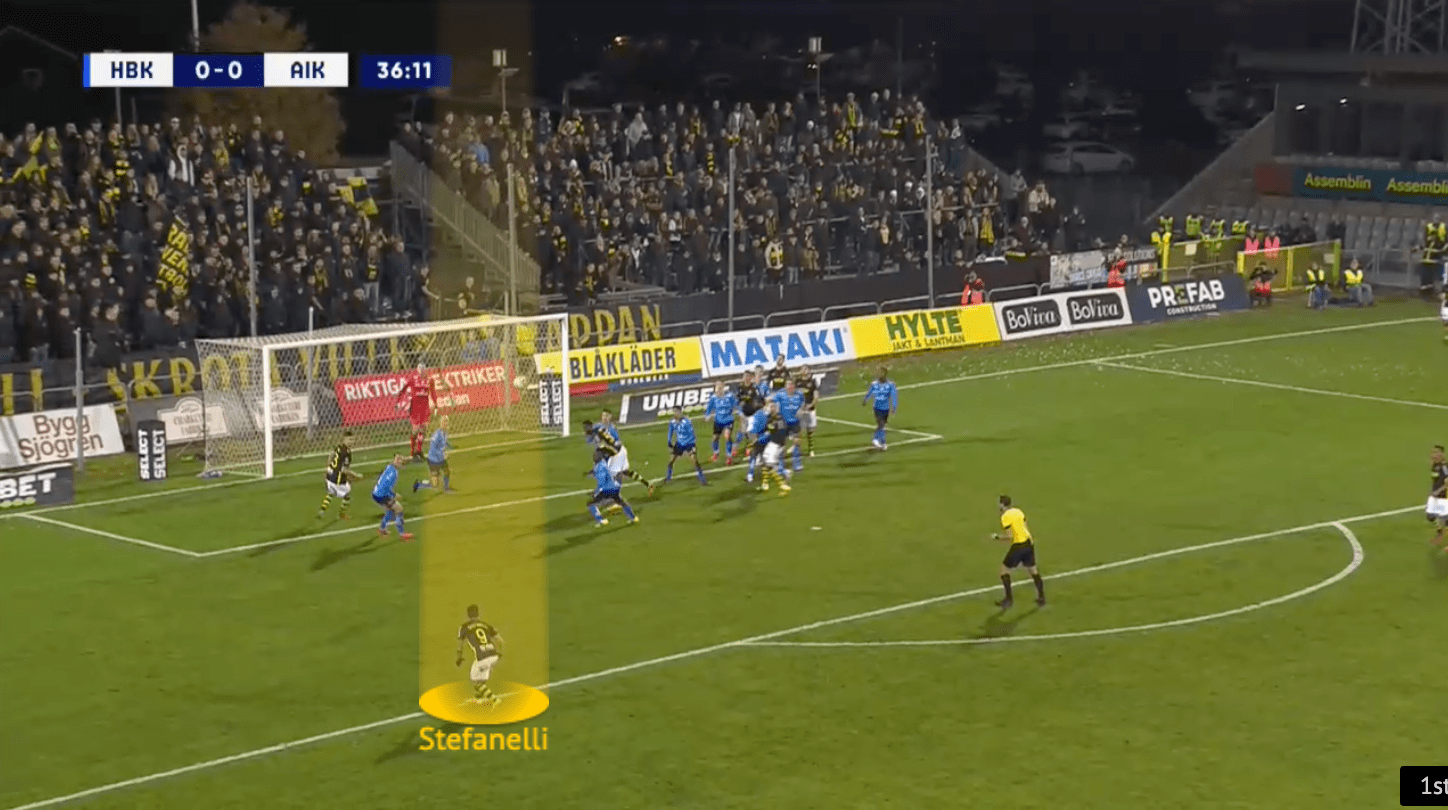
But, when the ball was delivered and contact was made in the front side, Stefanelli knew the ball was dropping to the outside of the penalty zone. And, see how quick he prepared himself for an attempt, now he was ready for a left-footed shot when the ball dropped.
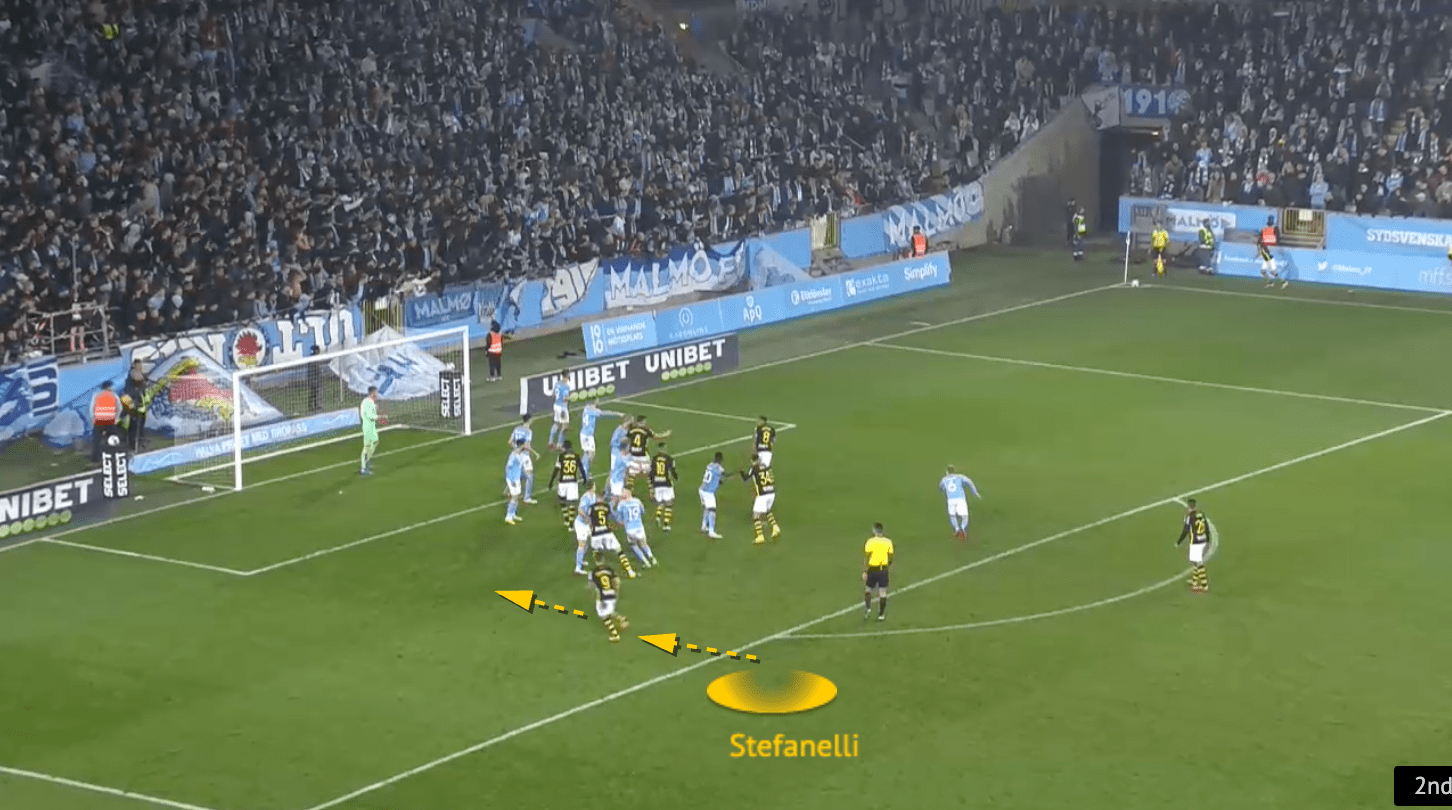
We can see another example of Stefanelli’s behaviours in the rest defence. Against Malmö, AIK only had one corner and they were one-nil down, when the AIK players attracted the opponents to the front area, Stefanelli already moved behind everyone to the far side. Since he was part of the rest defence, no one marked him.
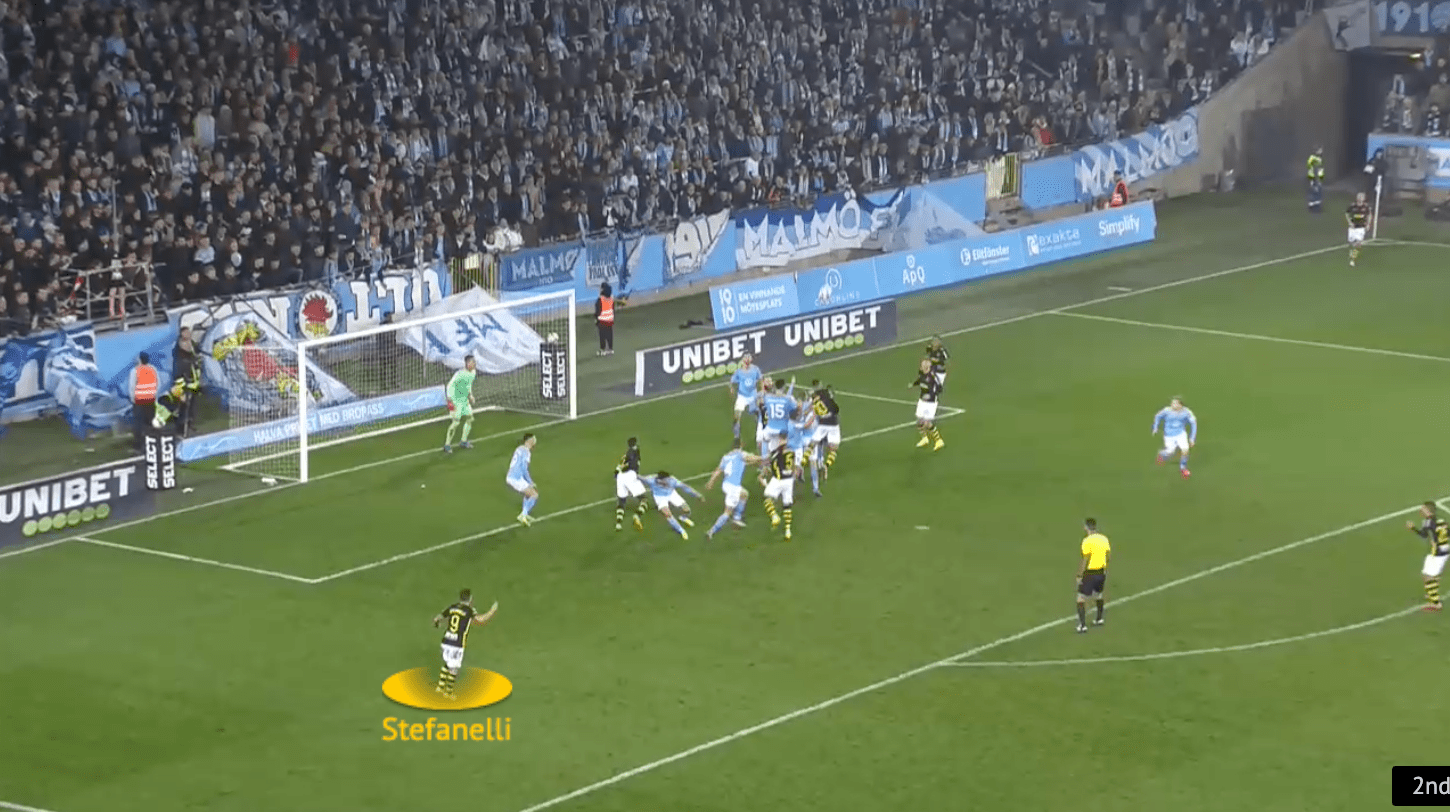
The delivery was sent to the front side and both sides were competing. Hence, Stefanelli had to stop, wait and see what was going on, not going all the way into the six-yard box because that was unnecessary.
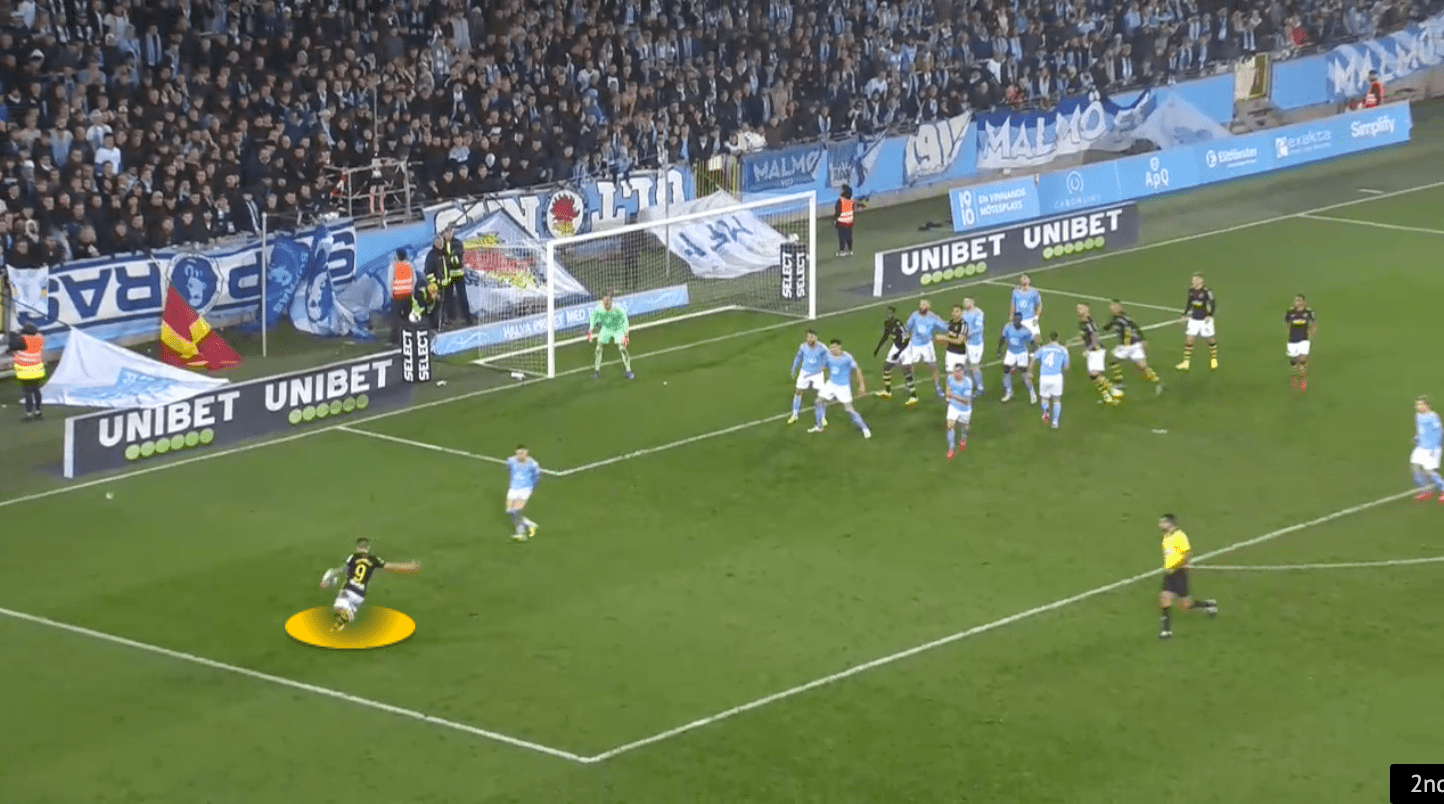
That pause, was very important because overran would expose AIK in the transitions. But Stefanelli was clever, he stayed. And now, he caught the second ball and there was a chance to cross again. From these small adjustments within a few seconds, you could see how Stefanelli adapted his decision based on the surroundings and that was valuable to the team.
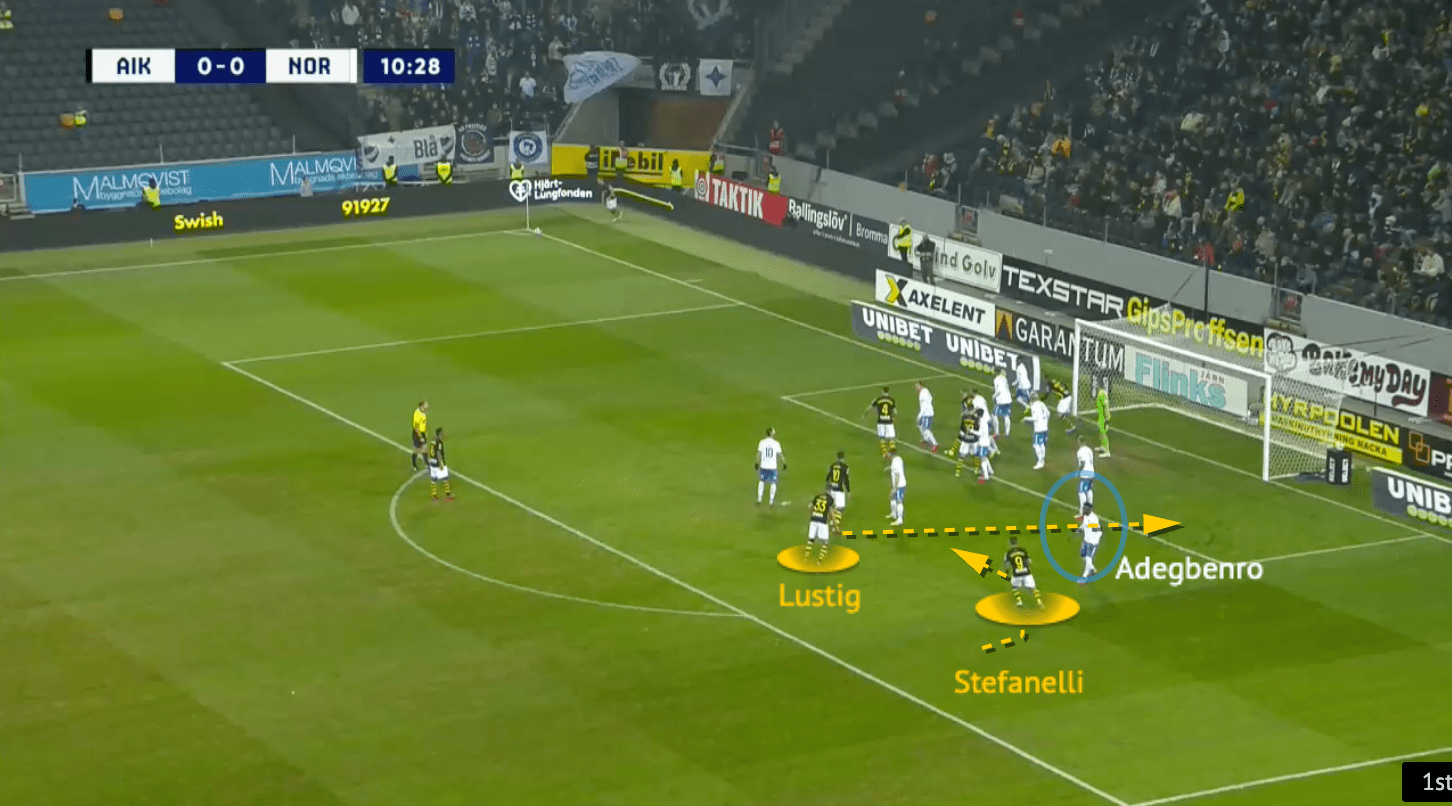
Stefanelli’s presence could also help the other parts of the attack, strategies we explained previously could be mingled with his move if needed. Against IFK Norrköping, which was an interesting opponent with their “zonal + man-marker + blocker” setup, Stefanelli lurked inside the penalty box far side early.
Lustig attacked the far post from deep as usual, but help was needed to make sure the blocker was not stopping him – Stefanelli was the help. Here, he moved to the centre, attracted Samuel Adegbenro.
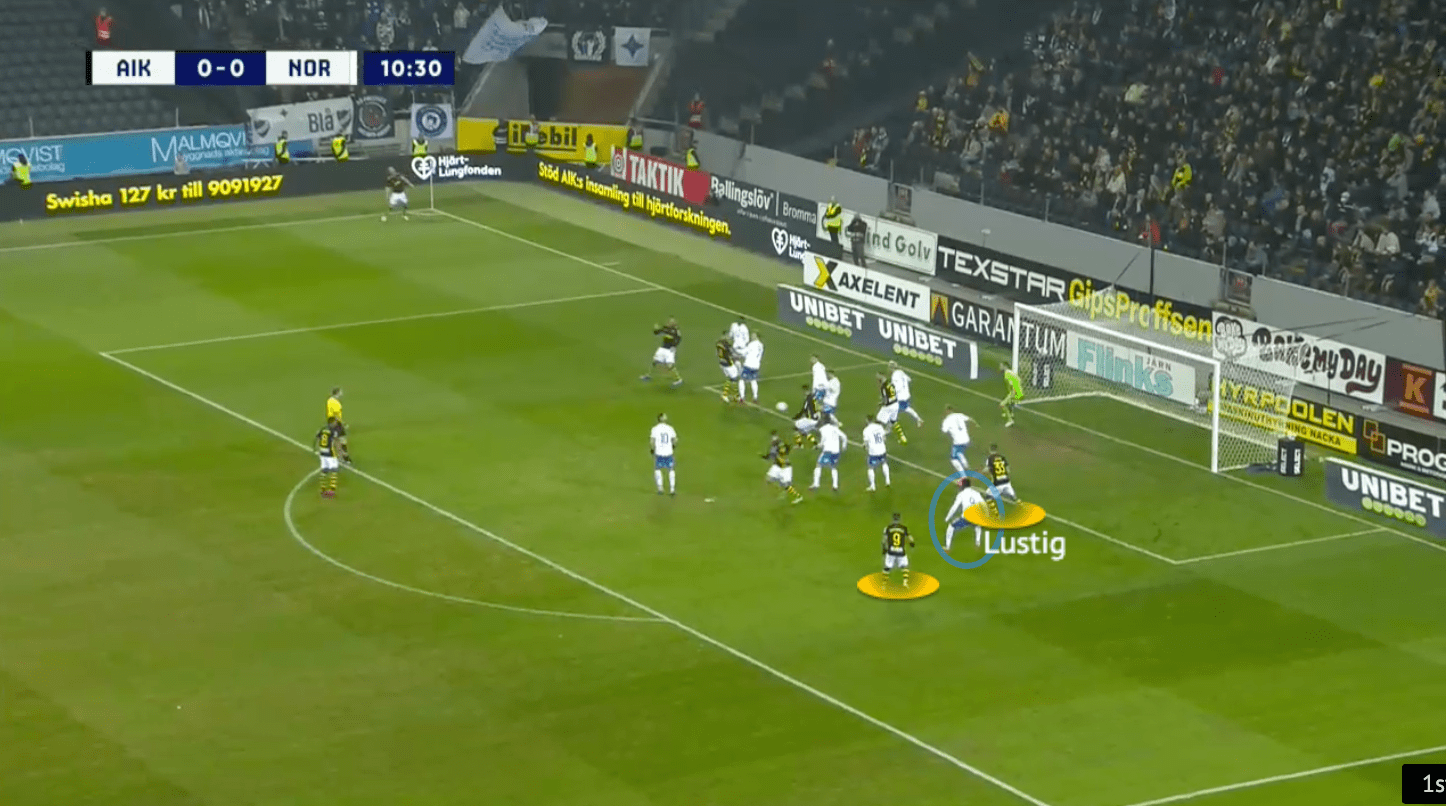
And so, when Lustig ran past the lines into the six-yard box, there was no interference because Adegbenro was fixed by Stefanelli.
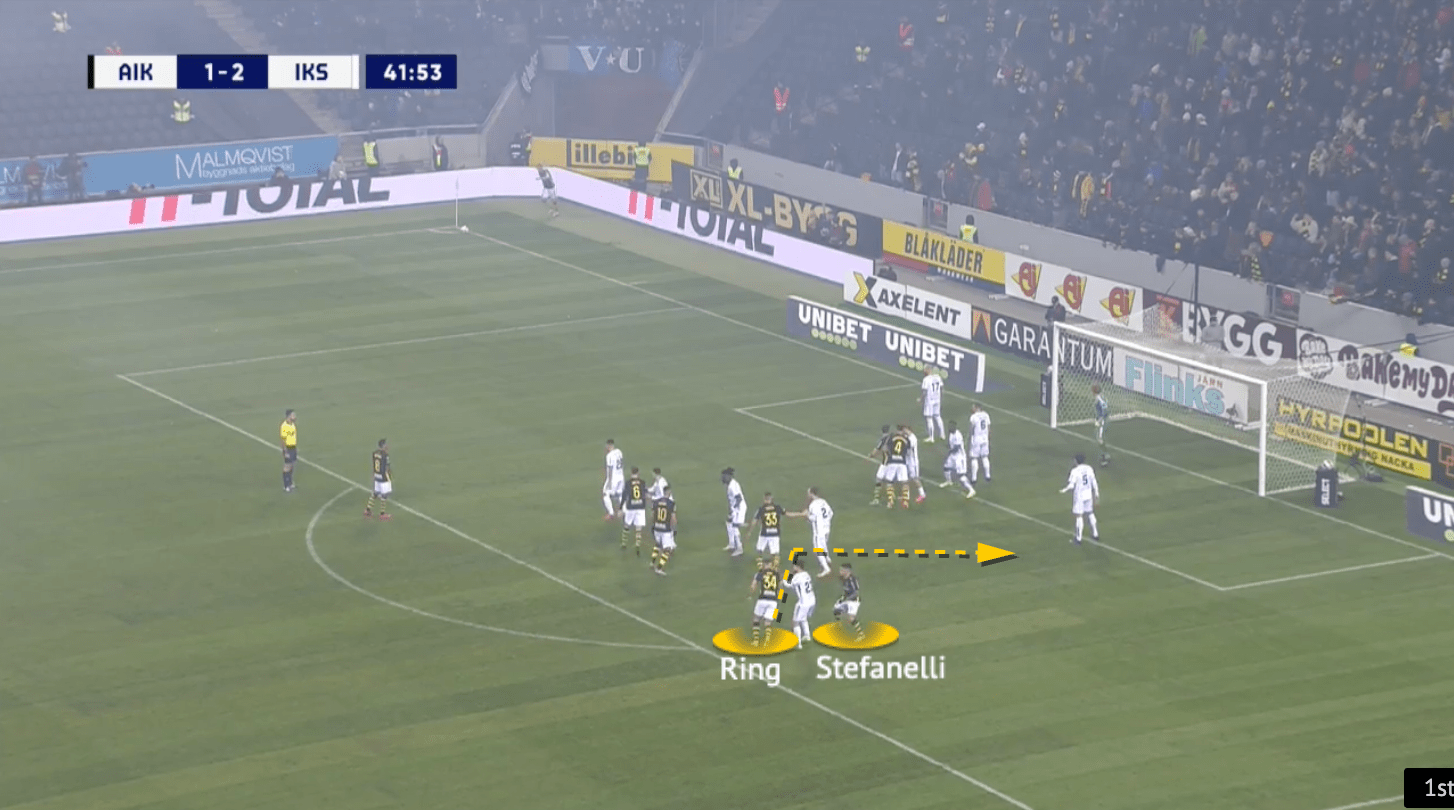
Alternatively, to allow the deep runners to get into goal-scoring positions or back post, Stefanelli could engage the man-marker or blocker. Here, Ring wanted to attack from deep, and Stefanelli was around to help.
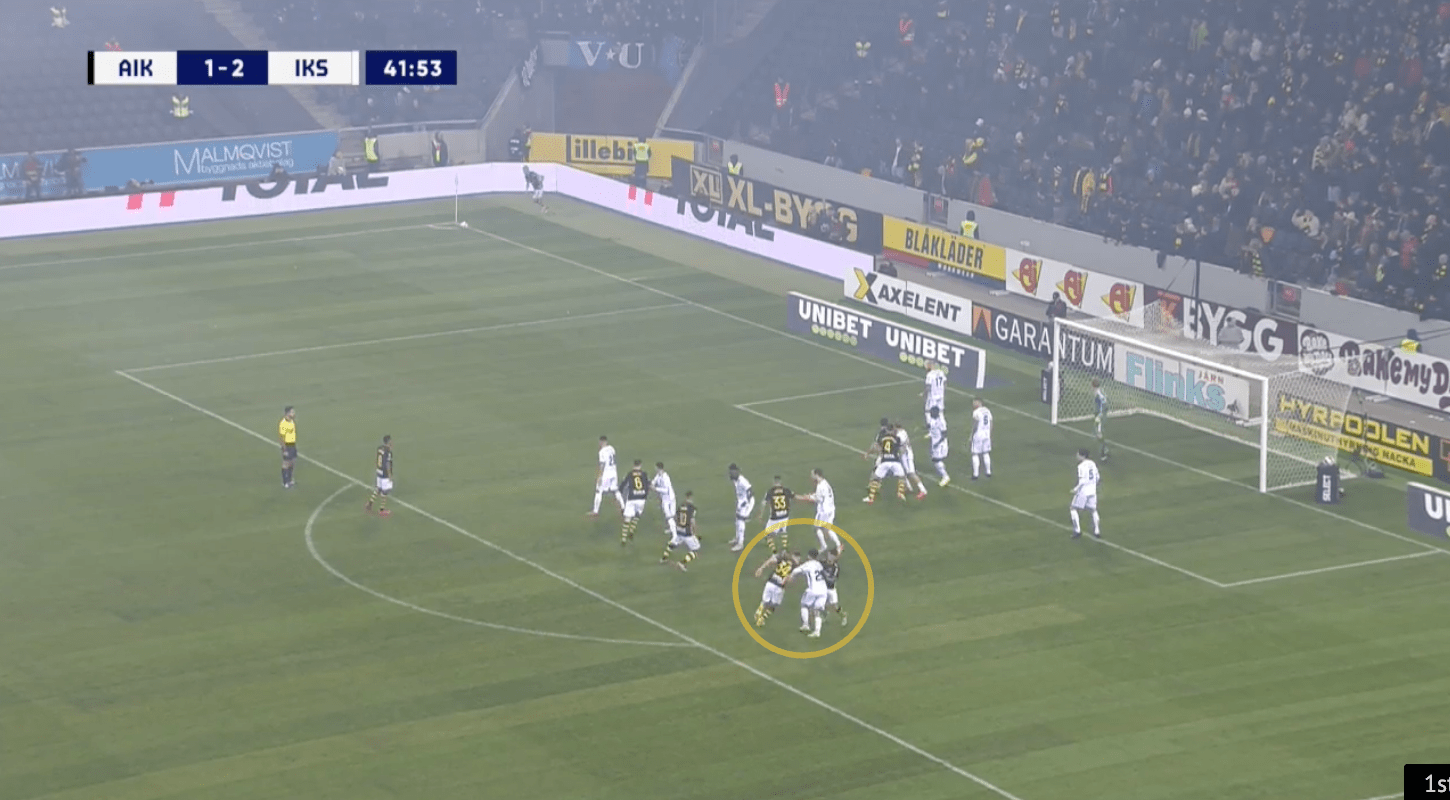
When Ring moved, the Argentine picked his marker, so Ring could earn that one second to outrun the marker freely. This was another example of how the rest defence could help the attack as well, not only waiting in front of the penalty zone.
Conclusion
As we have shown in this analysis, AIK have so many strategies to create opportunities in the offensive corners, that made them one of the best sides in Allsvenskan 2021. Among those strategies, the most impressive part of the setup was their ability to “force” luck, because they had many players spreading in different areas to retrieve the second balls for another opportunity.
Although Goitom retired this year, they did not have key players departing so far, and reinforced with the arrival of Henry Meja and Jesper Ceesay. Let’s see whether Grzelak could keep Gnagets in the title race in 2022.





Comments